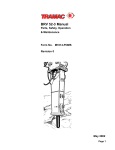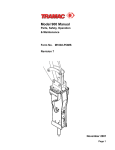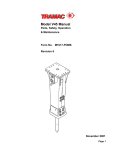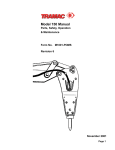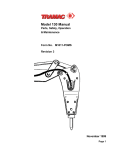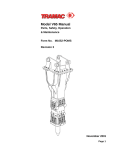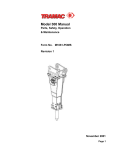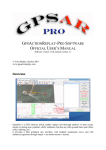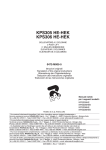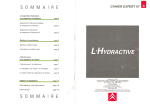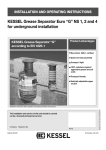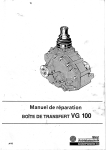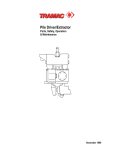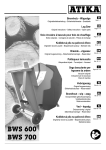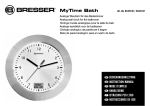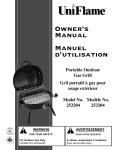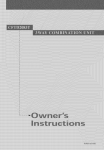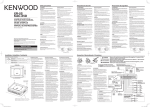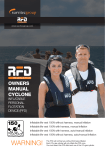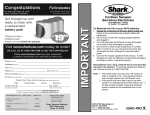Download Model 1200 Manual
Transcript
Model 1200 Manual Parts, Safety, Operation & Maintenance Form No. M1007-POMS Revision 5 November 2001 Page 1 Model 1200 Quick Reference Quick Reference Parts Part Number Ref # 450 460 490 680 710 700 690 720 86419595 86581105 86581113 86447349 86582020 86447372 86504198 86589934 93661 N/A N/A 93973 N/A 93837 96177 N/A 1 1 1 1 1 1 2 2 Strike piston Spacer Cylinder Upper chuck bushing Lower chuck bushing Bushing retaining pin Plug Retaining pin 620 630 86355518 86230059 74257 6178 1 1 Fittings for manual greasing Pour graissage manuel Threaded plug Bouchon fileté Oiler Graisseur 740 750 86447380 86317435 93592 57369 4 4 Assembling bolt Nut Vis d'assemblage Ecrou 20 30 40 50 60 70 80 90 100 86486958 86589298 86307493 86576428 86576394 86307493 86510005 86502762 86592508 95044 N/A 51743 97062 97061 51743 96574 96138 N/A 2 2 24 12 14 56 14 2 2 STANDARD CRADLE Guiding slipper Guiding slipper Washer Screw UNF1” Fixing Cap Bolt Washer Nut Shock absorber Bar BERCEAU STANDARD Patin de guidage Patin de guidage Rondelle Vis UNF 1" Vis UNF 1” Rondelle Ecrou H Amortisseur Barrette 86447968 86248283 86265048 86241403 73859 73861 94172 17639 26428 14826 1 1 1 1 1 1 Moil point Chisel Seals package Diaphragm Inflating screw Inflating ring Broche pic Broche burin Pochette recharge Membrane d’accumulateur Vis de gonflage Bague BS 960 Page 2 Qty. DESCRIPTION Item Piston de frappe Entretoise Cylindre Douille supérieure Douille inférieure Axe d'arrêt Bouchon Clavette de retenue Model 1200 Quick Reference Quick Reference Torques DESCRIPTION Part Number Ref # Assembly Side Rods 86447380 93592 86317435 57369 4 4 Bracket Cap Bolts 86576394 97061 Fixing cap bolts 470 ft-lbs. Wear plate Bolts 86576428 97062 Guiding slipper bolts 660 ft-lbs. 77088 89496 26428 77230 H.P. accumulator Accumulator bolts Inflation screw Accumulator fixing bolts 470 psi charge pressure 221 ft-lbs. 16 ft-lbs. 470 ft-lbs. Assembling bolt Nut Pull the nuts to 150 ft-lbs in a crisscross pattern. Align the notches. Next, pull five more flats: Two flats, two flats and one flat in a crisscross pattern. Go 1/4” past notch and release to remove pretwist in rod. Accumulator 86363199 86410461 86265048 86363660 Page 3 Model 1200 Table of Contents Forward Avant Propos 5 Safety Securite S1 Ten Commandments Dix Commandements O1 Overall Dimensions Encombrement O2 Technical Specifications Caracteristiques Techniques O3 Mounting Montage O6 Tool Mounting Montage de Outil O8 Operation & Adjustment Utilisation & Reglage O10 Maintenance Entretien O13 Underwater Operations Sous - Marine les Fonctionnements O15 Tool Guide Guide Outil O16 Parts List Pieces Detachees P3 Accessories Accessoires P8 Trouble Shooting Incidents Techniques M1 Disassembly Démontage M4 Accumulator Accumulateur M8 Parts Inspection Exam des Pièces M12 Assembly Assemblée M27 At a Glance M35 Tooling Outillage M36 Assembling Support Support de Montage M38 Adaptation Kit Kit d’Adaptation M39 Lifting Accessory Accessoire de Levage M40 Long Term Storage Stockage Longue Durée M41 Breaker Pressurization Pressurisation du Brise-Roche M43 Grease Station Centrale de Graissage G1 Page 4 Model 1200 Forward FORWORD AVANT PROPOS The contents of this manual are considered to be proprietary and confidential to TRAMAC and should not be reproduced without the prior written permission from TRAMAC. Le contents de ce manuel est considéré comme appartenant à TRAMAC et comme confidentiel, il ne doit pas être reproduit sans I'autorisation écrite préalable de la société TRAMAC. Nothing contained in this document is intended to extend any promise, warranty or representation, expressed or implied regarding the TRAMAC products described herein. Any such warranties or other terms and conditions of sale of products shall be in accordance with the standard terms and conditions of sale of such products, which are available upon request. Aucun élément du contenu de ce document n’est entendu comme représentant aucune promesse, garantie, ni représentation, ni explicates, ni implicites, eut égard aux produits TRAMAC qui y sont décrits. Toute garanties de cette nature ou tout autres termes et conditions de vente des produits, doivent être conformes aux termes et conditions standard de vente de la société TRAMAC, termes et conditions que l'on pourra obtenir sur demande. This manual contains instructions and technical data to cover all routine operations and scheduled maintenance tasks by operation and maintenance staff. Major overhauls are outside the scope of this manual and should be referred to an authorized TRAMAC service department. The design specification of this machine has been certified as complying with E.C. directives. Any modification to any part is absolutely prohibited and will result in the CE certification and marking being rendered invalid. TRAMAC reserves the right to make changes and improvements to products without notice and without incurring any obligation to make such changes or add such improvements to products sold previously. Ce manuel contient des instructions et des données qui couvrent toutes les opérations et les tdches de maintenance régulière à effectuer par le personnel d'exploitation et de maintenance. Les révisions générales sortent du cadre de ce manuel et doivent être renvoyées à un service d'entretien agréé TRAMAC. Les spécifications de cet appareil ont été homologuées comme étant conformes aux directives de la CEE. Toute modification dune pièce quelconque est absolument interdite et auralt pour conséquence l'invalidation de I'homologation CE. La société TRAMAC se réserve le droit d'apporter des modifications ou d'ajouter des perfectionnements aux produits sans préavis et sans encourir en quoi que ce soit l'obligation d'apporter de telles modifications ni d'ajouter de tels perfectionnements aux produits vendus antérieurement. Page 5 Model 1200 Safety WARNING! ATTENTION! WARNING! - Pressurized component or system. ATTENTION! - Composant ou systéme sous pression WARNING! - Pressurized vessel (accumulator). WARNING! - Consult the operation and maintenance manual before beginning any maintenance. ATTENTION! - Consulter le manuel d'utilisation et d'entretien avant d'entreprendre toute interventions. ATTENTION! - Récipient sous pression (accumulateur) Lifting point. Point de levage. WARNING! - For operating temperature below 0º C, consult the operation and maintenance manual. 0º C ATTENTION! - Pour l'utilisation en dessous de 0º C, consulter le manuel d'utilisation et d'entretien. WARNING! - Risk of flying chips of rock - Keep clear, wear a helmet and safety glasses. ATTENTION! - Risques de projections - Rester à distance, porter un casque et des lunettes de sécurité. Page S1 Model 1200 Safety SAFETY SECURITE WARNINGS ATTENTION "Warnings" call attention to instructions which must be followed precisely to avoid injury or death. L'indication "ATTENTION" précise que les instructions doivent être suivies absolument pour éviter tout accident grave. CAUTION PRECAUTIONS "Caution" calls attention to instructions which must be followed precisely to avoid damaging the product, process or its surroundings. L'indication "PRECAUTION" précise que les instructions doivent être suivies absolument pour éviter d'endommager le produit, la procédure ou son environnement. NOTES NOTES Notes are used for supplementary information. L'indication "NOTE" donne des compléments d'information. SAFETY PRECAUTIONS PRECAUTION POUR LA SECURITE All mechanical equipment can be dangerous when used without care or if it is in bad condition. Tous les appareils mécaniques peuvent être dangereux s'ils sont utilisés sans précautions ou s’ils sont en mauvais état d'entretien. Ensure that the operator reads and understands the decals and consults the manuals before maintenance or operation. Vérifier que l'opérateur lise et comprenne les étiquettes, consulte les manuels avant toute opération et maintenance. Ensure that the operation and maintenance manual remains at operator's disposal. Assurer vous que le manuel d'exploitation et de maintenance reste à la disposition de l'utilisateur. Ensure that maintenance personnel are adequately competent and have read the maintenance manuals. Assurer vous que les personnels sont formés dune manière adéquate, qu'ils sont compétents et qu'ils ont lu les manuels de maintenance. Safety is not only a matter of warnings. Every time the operator is working with the breaker, the operator must be able to foresee any risks and how to avoid them. La sécurité n'étant pas uniquement une affaire d'instructions, chaque fois que l'opérateur travaille avec un brise roche, il doit penser aux risques qui peuvent survenir en cours de travail et prévoir les moyens de les éviter. Never undertake a new job or maintenance operation without being sure you and other people in the environment will be safe. Ne jamals commencer un travail ou une opération de maintenance sans être certain que vous et les personnes alentours resteront en sécurité. Page S2 Model 1200 Safety GENERAL INFORMATION INFORMATIONS GENERALES A rock breaker is an accessory for mini-excavators, backhoes or other excavators according to the model. Un brise roche est un accessoire adaptable aux mini-pelles, tracto-pelles ou pelles hydrauliques selon le modéle. The operator must have the necessary knowledge and must be allowed to operate such carriers. L'opérateur doit avoir acquis les connaissances nécessaires et doit être autorisé à conduire de tels engins porteurs, The operator must know the safety instructions concerning the carrier and comply with them. Il doit s'informer des consignes de sécurité propres à l’engin porteur et les respecter. In addition to the usual safety equipment such as helmet, safety shoes, the operator will, if need be, have available: - Safety glasses, industrial gloves, dust mask and ear protector. En plus de l'équipement de sécurité habituel (casque, chaussures de sécurité), l'opérateur devra, si la nature des travaux l'impose, se munir d'équipements tels que: - Lunettes et gants de protection, masque anti poussières, casque anti - bruit, etc. Ample, loose clothing, watches and bracelets, can in some circumstances be dangerous. Les vêtements amples, flottants, les bracelets montre et autres sont à proscrire car dangereux en certaines circonstances. The operator will not absorb any alcoholic drinks or medicine liable to generate sleepiness. L'opérateur ne doit pas absorber de boisson alcoolisée ni de médicament provoquant la somnolence pendant le travail. It is imperative to be informed and comply with all local laws and regulations concerning the breakers and their use. Il est par allieurs impératif de prendre connaissance et de respecter les règlements locaux concernant les brise roches et leur utilisation sur chantier. MOUNTING ON CARRIER MONTAGE SUR PORTEUR Each model of breaker is suited to a specific carrier. Chaque modèle de brise roche est adapté à un type d'engin porteur. The operator must be informed of the technical instructions given by the manufacturer, such as carrier minimum weight, working pressure, flow rate, hoses, dimensions and connection to carrier's hydraulic circuit. L'opérateur dolt prendre connaissance des prescriptions d'utilisation fournies par le constructeur du porteur, telles que: - Poids minimum du porteur, pression d'utilisation, débit, dimensionnement des flexibles et raccordement au circuit hydraulique du porteur. Failure to follow these instructions could result in permanent damage to the hydraulic hammer ! Le non respect de cos prescriptions peut endommager gravement le brise roche! Page S3 Model 1200 Safety When someone helps to install the breaker, make sure any hand signals will be well understood. Lorsque un aide participe au montage du brise roche, s'assurer que les instructions données par gestes soient blen comprises. Unexpected boom movements, when installing the breaker could result in hand injury: - Be sure the carrier is immobile and stable. - Keep your hands clear when moving the boom end between fixing plates. - Do not use fingers to "feel" pin alignment. Un mouvement inattendu du bras de pelle lors du montage du marteau, peut être la cause d'accident aux mains: - S'assurer que le porteur est immobile et stable. - Ne pas laisser les mains à proximité lors de la descente de l'extrémité du bras entre les plaques de fixation. - Ne pas véritier I'alignement des passages d'axes avec les doigts. When connecting the breaker hoses to the carrier circuit, be sure the circuit is not under pressure (make sure that the hydraulic tank is not pressurized) or at high temperature. Lors du raccordement du brise roche au circuit hydraulique du porteur, s'assurer que le circuit nest pas sous pression (penser au réservoir pressurisé) ou à température élevée. The carrier engine must be stopped. Le moteur de l'engin porteur dolt être arrêté. Make sure that the HP and LP return hoses are well connected. Veillez à ce que les flexibles d'alimentation et de retour soient correctement branchés. Take all necessary steps to prevent oil leakages when connecting the breaker. Prendre toutes les mesures nécessaires pour éviter au maximum les pertes d'huiles lors du branchement du brise roche. HYDRAULIC FLUIDS FLUIDE HYDRAULIQUE Hydraulic fluids and lubricants can be dangerous to health if not used properly. Les huiles hydrauliques et lubrifiants peuvent être dangereux pour la santé s’ils sont utilisés incorrectement. Avoid ingestion, skin contact and inhalation. Ne pas avaler, mettre en contact avec la peau, ni Inhaler les émanations. Safety data sheets for oil and lubricants should be obtained from the lubricant supplier. Les fiches de paramètres de sécurité pour les huiles et lubriflants doivent être obtenues auprès du fournisseur. Should hydraulic oil come into contact with eyes, rinse them abundantly and consult a doctor. Si de I'huile hydraulique entre en contact avec les yeux, rincer les abondamment et consulter un médecin. Page S4 Model 1200 Safety Should hydraulic oil come into contact with skin, wash it off immediately. Nettoyer immédiatement la peau si de I'huile entre en contact avec celle-ci. Fine jets of hydraulic fluids at high pressure can penetrate the skin causing serious injury. - Be sure the circuit is not under pressure prior to any intervention. - Do not use your hand to check for hydraulic fluid leakages. - If hydraulic fluid penetrates the skin, get medical help immediately. Les jets d'huile hydraulique sous pression peuvent pénétrer la peau et provoquer de graves blessures. - Ne jamais intervener sur un circuit hydraulique sous pression. - Ne jamais utiliser la main pour chercher une fuite. - Si de I'hulle hydraulique pénètre sous la peau, consulter immédiatement un médecin. HYDRAULIC ACCUMULATOR ACCUMULATEUR HYDRAULIQUE Rock breakers incorporate one or two hydraulic accumulators containing nitrogen under pressure. Les brises roches comprennent 1 ou 2 accumulateurs qui contiennent de I'azote sous pression. Never attempt to open the accumulator covers. Ne jamais démonter les couvercies d'accumulateurs. If an accumulator needs to be repaired, contact your TRAMAC distributor. Si une intervention est nécessaire sur un accumulateur, consulter votre distributeur TRAMAC le plus proche. OPERATION UTILISATION If the carrier is in a work area where there is a risk of falling objects or rocks, the cabin must be equipped with an approved FOPS protection. S'il y a un risque de chutes d'objets ou de blocs dans la zone de travail, la cabine de l'engin porteur doit être équipée d'un système de protection homologué "FOPS'. Prior to starting work, the operator will make sure that there are no buried electricity, gas or water pipes or lines. Avant le démarrage de travaux l'opérateur doir s'informer, de tous passages de conduites d'é1ectricité, gaz, eau ou autres présentant un danger, dans sa zone d'intervention. The operator must take every step to illuminate or light up his working area and permanently take care of ground stability. L'opérateur doit prendre si nécessaire toutes pré cautions, pour signaler ou éclairer sa zone de travail et s'assurer en permanence de la stabilité du terrain sur lequel l'engin porteur doit évoluer. The rock breaker will be used on a clear working area orientated in such a way, that inevitable rock chips produced by the contact of the tool with the ground are not dangerous for the operator or any bystanders. Le brise roche doit être utilisé sur une aire de travail dégagée avec une orientation telle que les inévitables éclats de roche, produits par le contact de l'outil avec le terrain, soient sans danger pour le voisinage et l'opérateur. Page S5 Model 1200 Safety Stand clear from a breaker in operation. Ne pas rester à proximité du brise roche en fonctionnoment. It is highly recommended to have a protection grid in front of the excavator and in all places where special care and safety are necessary. Il est vivement recommandé de prévoir une grille de protection devant le poste de conduite de l'engin porteur et tous les endrolts indispensables à la sécurité de l'environnement immédiat du chantier. Depending on the job done with the breaker, a large quantity of dust could be produced. - Avoid inhalation. Use water spraying to drop dust. Pendant l'utilisation du brise roche, principalement en démolition, une quantité importante de poussibres peut être produite. - Ne pas inhaler. Utillser de l'eau pour abattre les poussières. Do not use the breaker for any other application than what it is intended for: Splitting blocks, digging trenches, demolition and excavations. Ne pas se servir du brise roche hydraulique autrement que pour les applications prévues casse de blocs, travaux de tranchées, fouilles, démolitions. Never use the breaker as a lever. Ne pas utiliser le marteau comme levier. Never use the breaker to lift loads. Ne pas utiliser le marteau pour soulever des charges. Using a rock breaker without tool retaining pins is forbidden. Do not use any other tools than those recommended by the manufacturer. L'emploi d'un brise roche hydraulique sans claveftes de retenue d'outil est interdit. Ne pas utiliser d'autres outils que ceux prévus par le constructeur. After a certain working time the rock breaker temperature could be high, therefore, avoid all contact with any parts until it has completely cooled down and the pressure relieved in the hydraulic circuit. La température du brise roche après le travail peut être élevée: Eviter tout contact avec les pièces du brise roche, attendre le refroidissement complet de ces dernières et la décompression totale des circuits hydrauliques. Should the tool be changed, wait for cooling and use proper gloves to protect your hands. En cas de changement d' outil, attendre que la broche soit refroidie et se protéger les mains avant toute intervention. CAUTION: The vibrations of the breaker exceed 8.2 ft/sec². ATTENTION: Les vibrations sur I'apparell dépassent 2,5 m/s². Do not touch the rock breaker while it is in operation. Do not leave any object on the breaker. Ne pas toucher le brise roche en fonctionnement, ni laisser aucun objet sur le brise roche. Page S6 Model 1200 Safety MAINTENANCE AND REPAIRING MAINTENANCE ET REPARATION All components, accessories, pipes and connectors added to the rock breaker should be: Tous les composants, accessoires, tuyauteries et connecteurs ajoutés au brise roche doivent être: - Of good quality, procured from a reputable manufacturer and, wherever possible, be of a type approved by TRAMAC. - De bonne qualité, produits par un fabricant de bonne réputation et d'un type agréé par TRAMAC toutes les fois que cela s'avère possible. - Compatible with the breaker maximal working pressure. - Compatible avec la pression de travail maximale autorisée du brise roche. - Accompanied by instructions for safe installation, operation and maintenance. - Accompagnés d'instructions pour pouvoir effectuer l'installation, l'exploitation et la maintenance sans danger. When replacing HP and return hoses use only hoses compatible with the maximum working pressure equipped with crimped end fittings. En cas de remplacement des flexibles d'alim entation et retour n'utiliser que des flexibles compatibles avec la pression d'utilisation maximum, équipés d'embouts sertis. The use of spare parts other than those included in the TRAMAC approved parts lis,t may create hazardous conditions over which TRAMAC has no control. Therefore TRAMAC cannot be held responsible for equipment on which non-approved spare parts are installed. L'utilisation de pièces de réparation autres que celles qui sont incluses dans la liste des pièces qui sont approuvées par TRAMAC, peut engendrer des conditions dangereuses sur lesquelles la société TRAMAC n'a aucun contrôle, par conséquent, la société TRAMAC ne peut être tenue comme responsable des équipements sur lesquels il est monté des pièces de réparation non homologuées. Page S7 Model 1200 Ten Commandments 1 Don’t ever modify the hydraulic installation set by the dealer. 6 Ne jamais pousser I'accélérateur jusqu'à dépasser la limite indiquée au moment des essais de mise en route. 2 Avoid any violent movement when the breaker is operating. 7 Eviter toute manoeuvre brutale du bras, alors que le brise roche est en phase de frappe. 3 8 Applied pressure is perpendicular to the material to be broken and always follows the tool. Imprimer au brise roche la bonne poussée, toulours perpendiculairement à la face du matériau à démolir. 4 9 Do not leave the breaker in the same spot for long periods of time (Short bursts = Production = Long tool life). Never use the tool as a lever or to lift heavy loads. Ne jamais se servir de l'outil du brise roche comme s'il s'agissait d'un levier ou d'un crochet de levage. Ne pas faire frapper le brise roche à vide, c'est à dire sans appul suffisant sur le matériau à démolir. Lubricate the tool every two hours, using only a molybdenum bisulphide grease. If a lubricating station is available, make sure it is full and check the proper operation of the pump before each shift. Lubrifier l'outil toutes les deux heures de travail environ, en utilisant une graisse au bisulfure de molybdéne. S'il y a une centrale de graissage, veiller à son remplissage en début de poste de travail et vérifier son bon fonctionnement. Replace the tool bushing when the wear limits are reached. Remplacer la douille d'usure lorsque celle-ci atteint la limite d'usure. Continuously check for loose nuts, bolts and fittings and immediately replace loose or broken items. Arrêter immédiatement le brise roche lorsqu'un tirant d'assemblage est desserré ou cassé. Ne pas insister plus de 15 secondes sur le même point, lorsque le matériau est particuliérement dur et tenace. 5 Avoid blank firing at all times. 10 Stop the breaker immediately when the blows per minute decrease below normal operating parameters or the hoses vibrate excessively. Arrêter immédiatement le brise roche lorsque les flexibles vibrent de facon excessive. Page O1 Model 1200 12 0 15 0 1 50 1 30 32 0 14 X Ø 27 Operating Weight Poids Total 1 30 3417 Lbs 1550 kg Dimensions in Millimeters Les Cotes Sont Données en Millimétres Page O2 Dimensions Model 1200 Technical TECHNICAL SPECIFICATIONS CARACTERISTIQUES TECHNIQUES TRAMAC Carrier recommended weight Adaptation sur pelles de poids conseiIIé: 19 to 33 Tons Recommended oil flow Dèbit d'huile recommandé 36 to 45gpm 140 / 170 lpm Minimum pressure at excavator pressure relief valve Pression minimale de déclenchement du clapet de sécurité de la pelle 2900 psi 200 bar Admissible counter pressure Contre pression admissible 175 psi 12 bar Ø of the HP hose (inside) Ø de la tuyauterie haute pression (intérieur) 1 in. 25 mm Ø of the LP hose (inside) Ø de la tuyauterie basse pression (intérieur) 1 in. 25 mm Weight (without adaptation kit, or tool) Poids (sans kit mécanique. ni outil) 2833 lbs 1285 kg Approximate weight in working order Poids moyen en ordre de marche 3417 lbs 1550 kg Height with standard moil point Hauteur avec outil pic standard 98 1/2 in. 2500 mm Overall width Largeur hors tout 21 1/4 in. 540 mm Striking rate Cadence de frappe 370 to 770 Adjusted pressure on breaker Pression réglée sur le marteau 2250 psi 155 bar Protection against idle running Protection contre marche à vide Yes Oui Tool diameter Ø corps d'outil 4.8 in. 122 mm IMPORTANT IMPORTANT The maximum authorized oil temperature is 176º F at breaker and 158º F in the excavator tank. La température d'huile maximale autorisée esi 80º C au marteau et 70º C au réservoir de la pelle. Rock breakers are designed to function with mineral oil with a viscosity of 32 cst at 104º F. Les brises- roches sont étudiés pour tonctionner avec de I'huile minérale dune viscosité de 32 cst à 40º C. For use with other fluids such as engine oil or synthetic fluids, consult your TRAMAC distributor. Pour utilisation avec d'autres fluides, huiles moteur ou synthétiques, consulter votre distributeur TRAMAC Page O3 Model 1200 Technical IMPORTANT IMPORTANT Prior to any mounting, the operator must make sure that the carrier characteristics correspond to the required specifications, mainly: - Weight, flow and setting of relief valve(s) mounted on breaker line (refer to technical specifications sheet). Avant tout montage, l'opérateur dolt s'assurer que le porteur devant être équipé, correspond aux spécifications données principalement: - Poids, débit et pression de tarage du(des) clapet(s) de décharge situé(s) sur la ligne brise roche (Voir feuille spécifications techniques). Prior to any mounting, a flow and pressure test of the breaker circuit is imperative. Un contrôle du débit et de la pression du circuit brise roche est indispensable. The operator will make sure the hydraulic installation is acceptable as given and it cannot allow the inverse feeding of the breaker by the "return line". Il doit vérifier que l'installation hydraulique est conforme au schéma de principe fourni et qu'elle ne permet pas I'alimentation inverse du marteau par le circuit "retour". Note: The breaker pressure line (HP line) is located on the right side of the breaker. Some carriers might have inverted piping (pressure line on the left side of the carrier boom). Note: La ligne d'alimentation (HP) est située coté droit du brise roche. Certains porteurs peuvent avoir des circuits inversés ( HP à gauche du bras). Clearly identify HP pressure and return lines on carrier boom. Identifier clairement les circuits HP et BP du bras. If necessary, cross over the breaker hoses to allow proper connection. Si nécessaire, croiser les flexibles de raccordement du brise roche pour permettre un branchement correct. Page O4 Model 1200 Technical Normal working Marche normale Fig. 1 Mechanically impossible (stop) Rendu mécanicanique impossible (butée) Normal working Marche normale Fig. 2 Possible Possible Precautions to be taken when connecting the breaker Précautions à prendre lors du raccordement Feeding the rock breaker by the "breaker" LP line, (which is theoretically possible when the carrier is fitted with an extra spool with 3 positions) is forbidden; otherwise the rock breaker may be damaged. L'alimentation du brise roche par le circuit retour "marteau" théoriquement possible lorsque le porteur est équipé d'un distributeur supplémentaire 3 positions, doit absolument être évit6é sous peine d'endommager le brise roche. It Is therefore essential to Pour cola, il faut Take necessary steps to avoid activating the spool in the wrong position: From P to return circuit of rock breaker. - For instance, adaptation of a stop under the control pedal (fig. 1) or mounting of a non-return valve on rock breaker LP line, between the breaker and the spool (fig. 2). Prendre les mesures nécessaires pour empêcher de commander le distributeur dans la mauvaise position: Passage de P vers circuit retour du brise roche. - Montage dune butée sous la pédale de commande (fig. 1), par example, ou bien montage d'un clapet anti-retour sur la ligne retour du brise roche, entre marteau et distributeur (fig. 2). Page O5 Model 1200 Page O6 Mounting Model 1200 Mounting MOUNTING ON EXCAVATOR MONTAGE SUR PELLE PREEOUIPEE Review the general safety instructions. Revoir les Instructions generales de socurite, entre autres, chapitre: Montage sur porteur. - Move the dipper stick end between the corresponding sides of the fixing cap. - Descendre le balancier entre les flancs. - Insert the pin (mark. 1) and secure it. - Engager l'axe (rep. 1) et l'immobiliser. - Move the linkage between the corresponding sides of the fixing cap. - Descendre la biellette entre les flancs correspondants. - Insert the pin (mark. 2), and secure it. - Engager I'axe (rep. 2) et l'immobiliser. - Swing the breaker to each end position and make sure that there is no interference with any parts of the boom end. - Connect the breaker hoses (mark. 3) onto pipe line at boom (mind the proper connection). - Swing the breaker to each end position. Hoses must not be caught, tight or rub against the carrier boom in any position. Do not use fingers to "feel" pin alignment! - Vérifier le débaftement du marteau et l'absence d'intertérences en positions extrêmes. - Brancher les flexibles de raccordement (rep. 3) du marteau (veillez au raccordement). - Vérifier le débaftement du marteau: Les flexibles ne doivent pas être tendus, pineés ou frofter contre le bras dans n'importe quelle position. Ne pas vérifier I'alignement des passages d'axes avec les doigts! Page O7 Model 1200 Tool Mounting Fig.B Fig.A 2 3 A 1 B Fig.C Fig.D 1 Fig.F Fig.E 2 1 5 Page O8 Model 1200 Tool Mounting TOOL MOUNTING MONTAGE DE L'OUTIL On a brand new breaker, remove the plastic protection cover at the bottom of the front guide. Dans le cas d'un brise roche neuf, enlever le bouchon de protection. Lift the breaker and position it horizontally. Lever le brise roche et I'amener à l'horizontal. Using a pin driver drive out the pin (mark. 1) through holes A. A l'aide d'un chasse-goupille, éjecter les axes (rep. 1), par les orifices A. Proceed the same with holes B and drive out pin shutters (mark. 2) and retainers (mark. 3). Faire de même par les orifices B pour sortir les obturateurs (rep. 2), ainsi que les clavettes (rep. 3). Hand grease the tool shank, the bushings and the retainers. Graisser l'emmanchement de l'outil, les douilles et les clavettes. Using a lifting device sized according to the weight of the tool, lift the tool keeping it horizontal. En utilisant un moyen de levage approprié au poids des outils, lever l'outil en le maintenant horizontal. Insert the tool into the front guide. Make sure that the flat edges are well positioned in order to insert the tool retainers. Engager l'outil dans le guide avant. Veillez à l'orientation des plats de l'outil par rapport au trou des claveftes. Do not use fingers to feel the alignment! Insert the tool retainers (mark. 3). Insert the pin shutters (mark. 2). Do not use fingers to push the retainer to the end! Ne pas vérifier I'alignement avec le doigt! Monter les 2 claveftes (rep. 3). Monter les 2 obturateurs (rep. 2). Ne pas repousser la clavette avec le doigt! Insert the pins (mark. 1). If necessary, change the o-rings. Monter les 2 axes (rep. 1). Si nécessaire, changer les joints toriques. TOOL REMOVING DEMONTAGE DE L'OUTIL Remove the tool retainers. Remove the tool. Démonter les clavettes. Extraire l'outil. Mind the tool temperature! Should the breaker be stored without the tool mounted, remount the tool retainers. Attention à la température! Si le marteau doit être stocks sans outil, remonter les clavettes. Page O9 Model 1200 Review the general safety instructions. Before operating the breaker, train yourself to check: - The position The rock breaker must be perpendicular to the material face at all times. - Down pressure To allow the breaker energy to be transmitted to the material and break it, the tool must be firmly pressed against the materia, while hammering. Down pressure is adjusted by pulling down the carrier boom, and, if required, correcting the breaker position. Keep the breaker perpendicular to the material face by operating dipper stick or bucket controls. - Down pressure must be correct If the down pressure is insufficient, the breaker energy will be partly dissipated into the tool, the breaker itself and into the carrier boom, instead of being transmitted to the material. This generates abnormal vibrations and induces blank strikes. If, on the other hand, the down pressure is so high as to lift the carrier at the moment of the breakage of the material, the carrier will drop suddenly, This will create dangerous and destructive shocks for the tool, tool retainers, breaker thrusts, carrier booms and other parts. The carrier boom cylinders can be damaged if they reach the end of their stroke. - Avoid blank strikes Prior to hammering, the tool must be pressed against the material face. Blank strikes (tool not properly in contact with the material) lead to fast wear of the tool retainer and is the origin of tool breakages. When blank striking, the breaker sounds high pitched and metallic. Page O10 Operation Revolr les Instructions générales de sécurité principalement chapitre "utilisation". Avant d'utiliser le brise roche pour la premiére fois , habituez vous à contrôler - La position Le brise roche doit toujours être perpendiculaire à la surface du matériau à casser. - La poussée Pour que l’énergie du marteau soit transmise au matériau et provoque sa rupture, il faut que l'outil soit maintenu fermement en appui contre le matériau pendant toute la durée de frappe. La poussée se règle en abaissant le bras du porteur, et, au besoin pour corriger la position du brise roche et le maintenir perpendiculaire à la surface à démolir en manoeuvrant les commandes de godet ou de balancier. - Il faut que la pousséo soit correcte Si la poussée est insuffisante, l’énergie du brise roche au lieu d'être transmise au matériau se dissipera en partie dans l'outil, dans le brise roche et dans le bras du porteur, créant des vibrations anormales et provoquant des frappes à vides. Si par contre la poussée est trop forte, au point de soulever le porteur, lors de la rupture du matériau, l'excavateur retombera brusquement en avant. Cela provoquera des chocs dangereux et destructeurs pour l'outil, les claveftes, les butées du brise roche, le bras et autres parties du porteur. Les vérins de bras du porieur ne doivent pas être en butée avant ou arriàre, lis n'y résisteraient pas. - Ne pas faire frapper le marteau à vide Avant de faire frapper le marteau, l'outil doit être en appui contre la surface à casser. Les frappes à vide (outil insuffisamment appuyé) provoquent la destruction rapide des clavettes de retenues et sont la cause de casses d'outils. Lorsque le brise roche frappe à vide, les coups ont un son aigu, métallique. Model 1200 When In use, keep the breaker perpendicular If the breaker is not perpendicular, the tool may slip off and get stuck between guiding bushings. Severe friction created between tool and bushings leads to seizing which will result in tool breakages, bushing breakages or the lower bushing sliding off. Energy dissipated into the side plates or into the cradle of the breaker leads to welding breakage. Never operate the breaker at the same place for more than 15 seconds. If the material has not been broken at this time, reposition the breaker in another spot. Operating the breaker too long at the same place may heat up the tool. This may cause the point to dull (mushrooming) and the shank to seize. When breaking boulders, do not start from the center. Production is higher when breaking slices, beginning at the most favorable faces. Do not use the tool as a lever - To finish splitting the rock. - To move boulders. High forces applied onto the breaker may be the origin of: - Cracks in the cradle or side plate welds. - Destruction of lower bushing by crushing it. - Tool breakage. Operation Pendant le travail maintenir le brise roche perpendiculaire Si le brise roche n’est pas perpendiculaire, l'outil glisse sous l'effet de la poussée et coince entre les douilles de guidage. Les frottements importants créés entre outil et douilles provoquent des grippages conduisant à la casse de l'outil, la destruction des douilles, voir l'extraction de la douille inférieure. L'énergie dissipée dans les plaques latérales ou le caisson du marleau, provoque la rupture des soudures. Ne pas faire frapper le brise roche au même endrolt plus de 15 secondes. Si la roche n'a pas cassée pendant cette période, repositionner le marteau à un autre emplacement. Faire fonctionner le marteau trop longtemps à la même place peut provoquer un échauffement important de l'outil: L'extrémité peut être refoulée (champignonnage), l'emmanchement peut gripper. Lors de la casse de blocs, il est préférable de ne pas les aftaquer au centre. Le rendement est bien meilleur en procédant par degré et en attaquant d'abord les faces les plus favorables. Ne pas utillsor l'outil comme levier - Pour finir de casser le matériau. - Pour déplacer les blocs. Les forces importantes appliquées au marteau sont à l'origine: - De fissuration des soudures du berceau ou des plaques latérales. - De la destruction de la douille inférieure par écrasement. - De la rupture de l'outil. Page O11 Model 1200 Operation Do not use the breaker under water Ne pas utiliser le marteau sous l'eau For underwater operation (even for a short time), it is essential to pressurize the breaker front part to prevent water from entering inside the breaker. Dans le cas d'un travail sous l'eau (même pour une courte durée), il est nécessaire de pressuriser la partie avant du marteau, pour éviter que l'eau ne pénètre à l'intérieur. See page O13. Consulter page O13. The breaker must be pressurized prior to being plunged into water and remain so while it is under water. Le marteau doit être pressurisé avant d'être immergé et jusqu'à ce qu'ii soit retiré de l'eau. Note: Pressurization is also essential every time there is a possibility for debris to enter the front part (scaling, for example). Note: La pressurisation est aussi indispensable chaque fois que des débris peuvent pénétrer dans le marteau (purgeage, par example). If the weather is cold, do not start work without preheating the breaker Par temps froid, ne pas commencer le travail sans avoir préchauffé le marteau Start up the carrier and preheat oil. Démarrer le porteur et faire préchauffer I'huile. Raise the breaker from the ground so that the tool is hung up and feed the breaker with reduced flow (idle the carrier engine) for 5 minutes. Lever le brise roche pour que l'outil ne soit pas en appui sur le sol, alimenter le marteau avec un débit réduit (moteur du porteur au ralenti) pendant cinq minutes. Commencer le travail en augmentant progressivement le débit. Start work increasing the flow gradually. Grease the tool shank Graisser l'emmanchement de l'outil If the breaker is not equipped with an automatic lubricating station, grease the tool shank every 2 hours ( 5 to 10 shots with a hand grease pump). Si le marteau nest pas équipé dune central de graissage automatique, graisser l'outil toute 2 heures de travail environ (5 ou 10 coups de pompe à graisse). Use molybdenum bisulphide grease Utillser de la graisse au bisulfure de molybdène Page O12 Model 1200 Maintenance Every 2 Hours Toutes les 2 heures Daily Toutes les jours Weekly Toutes les semaines Page O13 Model 1200 Maintenance EVERY 2 HOURS TOUTES LES 2 HEURES D'UTILISATION Grease the tool shank. Graisser l'emmanchement de l'outil. DAILY TOUSLES JOURS Check the breaker attachment at the boom end. Vérifier la fixation du marteau en bout de bras. Make sure that the side rod is not broken. Vérifier qu'un tirant d'assemblage ne soit pas cassé. WEEKLY CHAQUE SEMAINE Check tightening of side plates fixing bolts. Contrôler le serrage des boulons de fixation des plaques latérales. Check tightenning of wear plate screws. Contrôler le serrage des palques de guidage dans berceau. Remove the tool. Démonter l'outil. Check the tool shank and striking face conditions. Vérifier l’état de l'emmanchement et de la face de frappe. Replace the tool if deeply scratched. Remplacer l’outil s'il présente des grippages importants. Check the tool retainer condition. Vérifier l’état de la clavette de retenue. Replaced if it shows important marks. La remplacer si elle présente des traces de choc importants. Check the lower bushing wear. Contrôler l'usure de la douille inférieure. Call your TRAMAC distributor if wear limit is reached. Demander lintervention d'un technician TRAMAC pour la remplacer quand la limits de l'usure est atteinte. Check the grease level of the automatic greaser if installed. Vérifier le niveau de graise dans la centrale automatique si montée. Page O14 Model 1200 Operation The TRAMAC Model 1200 in the standard version must not be used for underwater work, even for very short periods of time. If the chamber between the piston and the tool fills with water when the piston strikes, the water will not be evacuated fast enough and a considerable pressure rise will then occur and destroy the piston seal (with a risk of piston seizure). Compressor Pressure: Pressure from the compressor must be at least 22 psi above the water pressure at the working depth. Water pressure equals 14.5 psi for every 30 feet of depth. Through the first 30 feet, 36.5 psi of air pressure is required. Tool Life: TRAMAC working tools are made from a special steel far superior to any tool steel commercially available. Unlike other tools on the market, our steel is hardened all the way through - no thin shell of hard steel which wears quickly. When the tools lose their edge, either at the tip or on the sides, it is possible to sharpen them without repeating heat treatment, using one of the following methods: A) With a milling or planning machine for chisels and spades or with a lathe for the moils and blunt tools. These operations must be completed using the adequate type of hard metal tool. B) By sharpening: This operation must be performed using a coolant to prevent the tool from overheating. As a general rule, never let the tool cool quickly or suddenly, even when it is used with the breaker. Caution Dipping the tool into water when it has been heated in the course of work or leaving it in the snow in the winter will result in a drenching effect on the tip or cutting bit and increase the risk of breakage. Tools are covered by TRAMAC against metal defects (very uncommon). It is not unusual that some operations (working at angles or blank firing) lead to tool breakage, including inside the chuck housing. The use of after market tools will void your warranty for any claim related to parts in contact with the tool (including the main piston). Page O15 Model 1200 Tool Guide How a demolition tool cracks rock and concrete When the hammer piston strikes the top of a demolition tool, it sends a compressive stress wave down to the working end of the tool. Provided that the demolition tool is in contact with the rock or concrete which requires breaking, it is this compressive stress wave which fractures the rock. Then, immediately following the compressive wave, a tensile stress wave is formed due to the hammer piston lifting from the top of the demolition tool. The cycle of compressive and tensile stresses flowing down the tool is repeated for each hammer blow. Obviously, anything that interferes with the strength of the compressive stress wave during service, for example "blank firing" or bending of the demolition tool due to leverage, will result in loss of breaker efficiency of up to 80% and possible failure of the tool itself. Correct operating conditions The continuous cycle of compressive and tensile stresses in the demolition tool, even under correct operating conditions, creates fatigue stress in the tool which can lead to the fatigue failure of the tool before it is worn out. Anything which interferes with the cycle of compressive and tensile stresses will also increase the level of fatigue stress being applied to the demolition tool and, thus, increases the risk of early fatigue failure of the tool. The main cause of increased fatigue stress in a demolition tool is any form of side pressure during service which creates bending. Thus, utilizing the tool as a lever, using an incorrect driving angle or attempting to break ground using the pull of the excavator are all detrimental to the life of a demolition tool and should be avoided. Caution The hydraulic power available in the machine far exceeds the strength of a demolition tool if it is used incorrectly and can "snap the tool like a pencil". Demolition tool fatigue failure Demolition tool fatigue failure will occur approximately 4 inches from either side of the chuck front face or through the retainer pin flat. Another slightly less common failure area can fall approximately 8 inches from the working end, subject to the nature of use. The fracture face itself will normally exhibit semi-circular polished area with the remainder being of rougher appearance. The polished semi-circular area is the fatigue area and generally starts from a damage mark or other stress initiated on the outside of the demolition tool and spreads inward. The fatigue area slowly widens until the stresses being applied to the demolition tool cause sudden failure of the remaining section. Generally, the size of the fatigue area indicates the level of stress applied to the tool, i.e., the smaller the fatigue area, the higher the stress level. However, it must be borne in mind that once initiation of a fatigue crack has taken place, it requires a lower stress level to cause it to grow. Page O16 Model 1200 Tool Guide Causes of increased fatigue stress in a demolition tool include A. Free running (or blank firing) Free running occurs when the hammer piston strikes the top of the demolition tool when the working end is not in proper contact with the rock or concrete to be broken. This includes jobs where the tool slides off the work and also when breakthrough of thin concrete slabs or boulders occurs. B. Cold: Low temperatures cause a demolition tool to be more susceptible to fatigue failure. Tools should be warmed before use. C. Mechanical and thermal damage: Any form of damage to the surface of a demolition tool renders it more liable to suffer fatigue failure. Thus, all care must be exercised to prevent scratches, gouges or weld marks occurring due to accidental damage, galling caused by contact between the tool and chuck bushing through the lack of lubrication or excessive bending. D. Lubrication: Care must be taken to avoid metal-to-metal contact that, as a result of galling, could cause deep damage marks which, in turn, may lead to the formation of fatigue cracks and eventually failure of the demolition tool. Make sure that the shank of the demolition tool is well lubricated before inserting it into the hammer. E. Corrosion: A rusty demolition tool is more likely to suffer fatigue failure. Keep tools well greased and sheltered from the weather when not in use. Typical failures TRAMAC demolition tools are manufactured from first class materials and then heat treated to produce a fatigue and wear resistant tool. Thus when a tool has apparently failed to give a satisfactory service life, a brief visual inspection can often give a quick indication about the cause. Wear is dictated by the conditions of the material being broken. In general, however, the following guidelines apply: Blank tools worn more than 1/3 of their diameter, or moils and chisels worn back more than 2 inches from the working end, are classed as reasonable life. Page O17 Model 1200 Tool Guide TRAMAC demolition tool guide A B C D E Ref Tool type Application A B C D E F Moil point Chisel In-line chisel Blunt In-line asphalt cutter Spade Frost Low abrasive, homogenous material Plastic or heterogeneous material Plastic or heterogeneous material Crumbly rock Asphalt cutter and trenching Asphalt and trenching Page O18 F Model 1200 Tool Guide BREAKAGE CHART Failure due to blank firing or excessive wear of bushings and/or chuck housing. NO WARRANTY Failure due to - operation with worn out retaining pins, - blank firing, - twisting tool. NO WARRANTY Fatigue breakage with typical fatigue wrinkles due to steel d efect. 100% WARRANTY Typical failure caused by misalignment between down pressure, hammer and tool (prying, levering). NO WARRANTY Breakage due to improper contact between the tool's tip and rock or concrete. NO WARRANTY Mushrooming or fast wearing caused by operating too long on the same spot. NO WARRANTY Page O19 Model 1200 This Page Left Blank Intentionally Cette Page est Laissée Blanche Intentionnellement Page P1 Parts MODEL 1200 PARTS MANUAL Form No. M1007-P Revision 5 November 2001 Page P2 Model 1200 Page P3 Parts List Model 1200 • • • • • • • • • • • Item Part Number Ref # 1 10 20 30 40 86363199 86447356 86268786 86363652 86363660 77088 93724 29203 77227 77230 1 1 1 1 8 50 60 70 80 90 100 110 120 130 86419280 86349883 86223542 86419298 86419272 86404308 86314952 86228970 86419603 92704 71817 67293 92705 92703 87786 56047 5346 18406 1 1 14 1 1 1 1 2 1 140 150 160 170 180 190 200 86404324 86349883 86375193 86404332 86314952 86228970 86419603 87795 71817 80250 87796 56047 5346 18406 1 1 1 1 1 2 1 210 220 230 240 250 260 270 280 290 300 310 86418274 86256005 86404290 86223872 86447182 86447315 86415239 86417169 86490687 86390879 86447216 93416 21910 87785 10380 93988 94164 90740 91217 82225 84320 93686 1 8 1 1 9 2 2 4 1 1 1 550 560 570 580 86231644 86238466 86355500 86352481 7294 12817 74256 73008 1 2 1 1 620 630 640 650 86355518 86230059 86261328 86476314 74257 6178 24850 93650 1 1 1 1 Included in Seal Kit Qty. Parts List DESCRIPTION DESCRIPTION ACCUMULATOR Accumulator Nylon ring O-ring Support disk Screw CHc UNF 1" ACCUMULATEUR Accumulateur Bague nylon Joint torique Disque d'appui Vis CHc UNF 1" SWIVEL LP Threaded plug O-ring Shim Spring stop Spring Slide Knee piece 1” 1/4 NPTF O-ring Threaded plug HP Threaded plug O-ring Up seal Slide Kneepiece 1” 1/4 NPTF O-ring Threaded plug GENOUILLERE BP Bouchon fileté Joint torique Rondelle de calage Butée de ressort Ressort Tiroir Genouillère 1” 1/4 NPTF Joint torique Bouchon fileté HP Bouchon fileté Joint torique Joint de tige Tiroir Genouillère 1” 1/4 NPTF Joint torique Bouchon fileté BACK HEAD Back head including: ( Helicoil thread UNF 1" ( Liner ( Rush O-ring Valve Spring Spring guide O-ring O-ring Distribution box Lubrication Knee piece screw Lip seal Knee piece Tight seal For hand greasing Threaded plug Oiler Grease pump Grease cartridge TETE ARRIERE Tete arrière comprenant: ( Filet hélicoil UNF 1” ( Chemise de tiroir ( Jonc Joint torique Clapet Ressort Guide resort Joint torique Joint torique Boite de distribution Graissage Axe de genouillère Joint a levres Genouillère Joint d’étanchéité Pour graiasage manual Bouchon filete Graisseur Pompe à graisse Cartouche de graisse Page P4 Model 1200 Page P5 Parts List Model 1200 • Item Part Number Ref # 320 330 340 350 360 370 86447240 86474657 86447257 86447224 86400413 86447232 93685 94433 93689 93687 86603 93688 Parts List DESCRIPTION DESCRIPTION 1 1 1 1 1 1 DISTRIBUTION Distributor Upper liner Overpressure valve Uner O-ring Slide DISTRIBUTION Distributeur Chemise haute Clapet de surpression Chemise Joint torique Tiroir SPACER Pin Pin Thrust piston guide Thrust piston Strike piston Spacer O-ring Tight seal PARTIE ENTRETOISE Axe lisse Goupille Culasse Piston de poussée Piston de frappe Entretoise Joint torique Joint d'étanchéité PARTIE CYLINDRE Cylindre Axe lisse Butée d'emmanchement Joint à lèvres inégales Sans pressurization Bouchon filete Qty. • • 410 420 431 440 450 460 470 480 86350014 86350006 86564952 86447208 86419595 86417755 86280286 86352481 71848 71847 96723 93651 93661 92953 36579 73008 1 1 1 1 1 1 1 1 • 490 500 510 520 86417748 86350014 86420742 86487139 92952 71848 93885 93880 1 1 1 2 531 86512621 96704 1 CYLINDER Cylinder Pin Shank thrust Unequal lip seal Without pressurization Threaded plug 601 602 603 604 605 606 607 608 609 610 660 670 680 690 700 710 720 86350048 86285343 86477171 86353547 86352671 86220639 86352697 86378452 86355773 86378437 86350014 86417763 86447349 86504198 86447372 86447364 86589934 71863 40530 94614 73477 73154 75467 73156 81151 74317 81149 71848 92954 93973 96177 93837 93723 N/A 1 1 1 1 2 2 4 2 2 4 1 1 1 2 1 1 2 FRONT GUIDE Ball seat Ball Spring guide Spring Snap ring Elastic pin Lock Spring guide Spring Plug Pin Front guide Upper chuck bushing Plug Pin Lower chuck bushing Retaining pin GUIDE AVANT Siège de bille Bille Guide ressort Ressort Jonc Goupille élastique Vérrou Guide ressort Ressort Bouchon Goupille Guide avant Douille supérieure Bouchon Axe Douille inférieure Clavette de retenue 740 750 86447380 86317435 93592 57369 4 4 ASSEMBLING Assembling bolt Nut ASSEMBLAGE Vis d'assemblage Ecrou • Included in Seal Kit Page P6 Model 1200 Parts List Excavator Side Côté Pelle 40 30 20 10 * Remove Plug * Enlever le Bouchon * Page P7 Model 1200 Qty. DESCRIPTION DESCRIPTION N/A 95044 N/A 51743 97062 97061 51743 96574 96138 N/A 83592 1 2 2 24 12 14 56 14 2 2 1 CRADLE Standard cradle Cradle including: (Guiding slipper (Guiding slipper (Washer “Two mounted at a time” (Screw UNF 1” Screw UNF 1” (Washer “Two mounted at a time” Nut Shock absorber Bar Shock absorber BERCEAU Berceau standard Berceau comprenant: (Patin the guidage (Patin the guidage (Rondelle “montées par deux” (Vis UNF 1" Vis UNF 1” (Rondelle “montées par deux” Ecrou H Amortisseur Barrette Amortisseur 73859 73861 73860 73862 73864 1 1 TOOLS Moil point Chisel Long moil point Long chiesel Blunt tool OUTILS Broche pic Broche burin Broche pic long Broche buring long Broche pilon 94172 1 1 1 9 1 1 2 4 1 1 1 1 2 ACCESSORIES Seals package including: ( Nylon ring ( O-ring ( O-ring ( O-ring ( O-ring ( O-ring ( O-ring ( Lip seal ( O-ring ( O-ring ( Tight seal ( Lip seal ACCESSOIRES Pochette recharge comp: ( Bague nylon ( Joint torique ( Joint torique ( Joint torique ( Joint torique ( Joins torique ( Joint torique ( Joint de tige ( Joint torique ( Joint torique ( Joint d'étanchéité ( Joint à lèvres 94474 19716 12817 7295 94469 1 1 2 1 1 Pressurization kit Knee piece axle Equal lip seal Knee piece Adaptor Kit de pressurisation Axe de genouilIère Joint à Ièvres égales Genouillère Adapteur Item Part Number Ref # 10 20 30 40 50 60 70 80 90 100 800 86581238 86486958 86589298 86307493 86576428 86576394 86307493 86510005 86502762 86592508 86388014 960 • 86447968 10 20 250 300 290 60-150 120-190 160 360 470 480 520 10 20 30 40 86475100 86251832 86238466 86231651 86475050 Parts List Page P8 Model 1200 Sound Proof Option Item Part Number Ref # Qty. DESCRIPTION DESCRIPTION 10 20 30 40 50 60 70 80 90 100 110 800 1 2 2 24 12 1 14 56 14 2 2 1 Soundproof cradle Cradle including: (Guiding slipper (Guiding slipper (Washer “two mounted at a time” (Screw UNF 1” Sound proofing kit Screw UNF 1” Washer “two mounted at a time” Nut Shock absorber Bar Shock absorber Berceau d'insonorisation Berceau comprenant: (Patin de guidage (Patin de guidage (Rondelle “montées par deux” (Vis UNF 1” Kit d’insonorisation Vis UNF 1” Rondelle “montées par deux” Ecrou H Acortisseur Barrette Amortisseur Page P9 86592185 86486958 86589298 86307493 86576428 86592466 86576394 86307493 86510005 86502762 86592508 86388014 N/A 95044 N/A 51743 97062 N/A 97061 51743 96574 96138 N/A 83592 Model 1200 Accumulator 1200 Accumulator HP/HP Accumulateur Tightening torque Couple de serrage = 221 ft-lbs = 300 Nm Nitrogen pressure Pression de gonflage = 470 psi = 32,5 bar Item Part Number Ref # Qty. DESCRIPTION DESCRIPTION 10 20 30 40 50 60 86363199 86265048 86241403 86410461 86363215 86248283 86349818 1 1 1 16 1 1 1 Accumulator including: Inflation screw Ring Screw CHc UNF 3/4” Upper flange Diaphragm Lower flange Accumulateur comprenant: Vie de gonflage Bague BS Vis CHc UNF 3/4” Flasque supérieur Membrane d’accumulateur Flasque inférieur 77088 26428 14826 89496 77090 17639 71802 Page P10 Model 1200 This Page Left Blank Intentionally Cette Page est Laissée Blanche Intentionnellement Page P11 Model 1200 Trouble Shooting TROUBLES SHOOTING … REMEDIES A - Oil leakage on hammer. PANNES POSSIBLES … REMÉDES A - Fulte d'hulle au niveau du marteau. Damaged or worn seals. Call your TRAMAC distributor. Joints d'étanchéité endommagés ou usés. Consultez votre distributeur TRAMAC le plus proche. B - The breaker loses power; high vibrations in breaker hoses. B - Le marteau manque de puissance, les flexibles de raccordement battent. The accumulator is deflated or diaphragm punctured. Check the oil temperature. If oil is too hot, ask a technician to check the breaker circuit relief valve setting. Call your TRAMAC distributor. L'accumulateur est dégonflé, la membrane de I'accumulateur est percée. Vérifier la température de I'huile. En cas d'échauffement important, faire vérifier par un technicien, le réglage des clapets de décharge du circuit de pelle. Consultez votre distributeur TRAMAC le plus proche. C - The hammer operates normally, then slows down and stops. A few minutes later the hammer will start again then stop again. C - Le marteau fonctionne normalement puis la cadence ralentit et le marteau s'arrêite. Quelque temps après le marteau redémarre puis s'arrête. Hydraulic oil is too hot. Excavator circuit must be checked for heat source. If necessary reduce the breaker operating pressure. L'huile hydraulique est trop chaude. Le porteur doit être vérifié pour trouver l'origine de l'échauffement. Si nécessaire réduire la pression de frappe du marteau. D - One side rod bolt has broken. D - Un tirant d'assemblage est cassé. Stop working immediately and call your TRAMAC distributor. Arrdter le travail immédiatement. Consultez votre distributeur TRAMAC le plus proche. E - After connection to carrier, the breaker operates for few blows then stops. E - Après adaptation au porteur, le marteau tape quelques coups puis s'arrête. The return hose is plugged, check the quick coupling seat (if installed). Le flexible retour est bouché, vérifier le coupleur (si montée). Recommendation: Check oil temperature and settings of carrier relief valves. If relief valve is not adjusted properly, oil may heat up quicker due to the high total power of rock breaker. This will cause the rock breaker to perform poorly. Recommandation: Le brise roche ayant une puissance globale élevée, veiller au bon refroidissement de I'huile. Un mauvals réglage du clapet de surpression du porteur peut être la cause d'un échauffement important de I'huile entrainant un mauvais fonctionnement du brise roche. Page M1 Model 1200 Trouble Shooting TECHNICAL PROBLEMS Before looking for a hammer problem, look for a problem in the installation, like bad quick couplers or a plugged filter [see page M3 for how to check the installation]. Make sure that the hammer has not been hooked up backwards. Make sure that the hammer has the proper tool. Make sure that the down pressure has been applied. Make sure that no valve(s) are closed. For any other problem, refer to the Trouble Shooting page M1. If you cannot identify the problem, BEFORE calling your TRAMAC dealer, collect the following information. A complete diagnosis cannot be done without it. A. B. C. D. Flow rate in high pressure line running to the hammer at operating temperature and operating pressure. Value of high pressure at hammer inlet when hammer is operating (use a 0-3000 psi gauge). Value of back pressure in return line (use a 0-300 psi gauge). Setting of relief valve in the system. For more details, please refer to page M3. Low Pressure Gauge 0-160 Psi Return and Supply Lines (Same Size as Breaker) Flow Meter Flow Scale Oil Temperature Gauge Pressure Gauge Page M2 Needle Valve Model 1200 Trouble Shooting How to check hydraulic circuit and installation Mount a flow meter in place of the hammer. Also, mount a low pressure (0-300 psi) gauge on the outlet of the flow meter in order to test the back pressure in the return circuit With the flow meter in place, activate the circuit and bring the machine up to operating temperature; do not test the machine cold. If the control valve is equipped with solenoid, switch on the solenoid before starting the engine to avoid damage to the flow meter. Do not switch on or off the solenoid when the engine is running. Adjust the flow output to match the requirements of the breaker (36 to 45 gpm). After the flow has been adjusted, load the flow meter to the hammer operating pressure 2250 psi value plus 600 psi, and readjust the flow if necessary to keep the hammer flow value constant for pressure varying between 1000 psi and hammer operating pressure value (2250 psi) plus 600 psi. Relief valve problems If you cannot reach the proper oil flow at the hammer operating pressure value plus 600 psi, you may have a bad system relief setting or a bad hammer control valve. To check system relief valve see excavator manual for proper relief setting. Build pressure with flow meter to determine relief cracking pressure (usually 50 to 200 psi below relief setting). Reset relief if needed. There should be 400 to 500 psi between hammer regulated pressure value and system cracking pressure or heat may develop. Pump problems If you cannot produce proper oil flow against pressure varying from 1000 psi to hammer operating pressure plus 600 psi, the pump could be bad or there is excessive leakage in the circuit. Hammer control valve problems If relief valve and pump are good, open and close valve three or four times: The valve spool may be sticking or back pressure is developing on return line. With the flow adjusted and the flow meter loaded to hammer operating pressure value plus 600 psi, take note of the low pressure gauge reading. The return pressure should be less than 175 psi. If the back pressure is more than 175 psi, the restriction causing this higher pressure must be found and eliminated. After the flow meter test is completed, disconnect the flow meter and connect the hoses to the hammer. Mount a high pressure gauge (0-3000 psi) on the hammer HP line and take the machine outside. Run the hammer on a heavy 3 inch by 40 inch by 40 inch steel plate on hard ground and take note of the pressure reading. Call your TRAMAC dealer if pressure adjustments are needed. Page M3 Model 1200 Disassembly DISMANTLING DÉMONTAGE V1200 to SN 132872: Prior to removing the breaker from its cradle, remove the oiler holder plug. V1200 jusqu’a SN 132872: Avant de retirer le marteau de son caisson, démontez le bouchon porte graisseur. - Loosen and remove the fixing cap bolts. - Desserrez les vis de fixation du chapeau. - Remove the fixing cap and the upper suspension. - Démontez le chapeau de fixation et I'amortisseur supérieur. - Remove the breaker from its cradle and place it on the mounting support (page M38) placed in the pit after having being equipped with the adaptation kit (page M39). - Retirez le marteau de son caisson et placez le sur le support de montage (page M38) placé dans la fosse après avoir été équipé du kit d’adaptation (page M39) - Loosen the LP swivel plug and remove the plug, the spring, the spring thrust and the adjusting shims. Fig. A - Loosen the HP swivel plug and remove the plug, the slide and the swivel. Fig. B A - Dévissez le bouchon de genouillère BP et retirez ensemble bouchon, ressort, butée de ressort, cales de réglage, tiroir et genouillère. Fig. A B - Dévissez le bouchon de genouillère HP, retirez le bouchon, le tiroir et la genouillère. Fig. B - Devissez les vis de fixation et retirez le disque. - Loosen fixing screws and remove the disk. - Remove the accumulator. Fig. C C - Retirez la genouillère HP Fig. C D - Using a syringe, drain oil contained in the breaker. Fig. D Page M4 - A I'aide d’une seringue, videz I'huile contenue dans le marteau. Fig. D Model 1200 - Remove the o-ring and the nylon ring. Fig. E E Disassembly - Retirez le joint torique et la bague nylon. Fig. E - Remove the distributor. Fig. F F Retirez le distributeur. Fig. F - Plug the back head to prevent particles from entering. Fig. G G - Bouchez la tête arrière pour éviter l'introduction de particules étrangères. Fig. G - Mark each side rod, nut and their mounting position. hole 1, rod 1, nut 1 hole 2, rod 2, nut 2 ... - Loosen and remove the 4 side rods. Fig. H - Repérez chaque ensemble vis/écrou et leurs emplacement de montage. vis 1, écrou 1, trou 1 vis 2, écrou 2, trou 2 ... H Never use a hammering wrench for side rods loosening. - Remove the back head. Fig. I - When removing the back head, be sure the 2 valves mounted in the back head stay in place. If necessary hold them. Fig. J - Débloquez et retirez les vis d'assemblage. Fig. H N'utilisez pas de clé à chocs pour desserrer les vis d'assemblage. I J - Retirez la tête arrière. Fig. I - Lors du démontage de la tête arrière, assurez-vous que les 2 clapets montés dans la tête arrière restent en position. Les tenir si nécessaire. Fig. J Page M5 Model 1200 - Turn the backhead over and remove the valves. Fig. K Disassembly K - Retournez le tête arriêre et retirez les clapets. Fig. K L - Chassez la boÎte de distribution à l’aide d’un maillet plastique. Fig. L Clapets Valves - Use a plastic sledge hammer to extract the distribution box. Fig. L M - Using a syringe to drain oil contained in the breaker. - Remove the back head positioning pin (A) and the thrust piston guide positioning pin (B) using a M8 screw. Fig. M N - A I'aide d’une seringue, videz I'huile contenue dans le marteau. - Retirez la goupille de positionnement de la tête arrière (A) et la goupille de positionnement de la culasse (B) à l’aide d’une vis M8. Fig. M - Retirez le clapet de surpression (A), la chemise haute (B), le tiroir (C) et la chemise (D). Fig. N - Remove the overpressure valve (A), the upper liner (B), the slide (C), and the liner (D). Fig. N O - Utilisez l’extracteur (repère 200, page M37) pour extraire la culasse. Fig. O - Use the extractor (item 200, page M37) to extract the thrust piston guide. Fig. O - Position and fix the flange (1) onto the thrust piston guide by means of screws (2). Place the tripod (3) and the ring (4). Using a 38 mm wrench, tighten the nut (5) to extract the thrust piston guide. Fig. p S 5 4 3 2 - Fixer la bride (1) sur la culasse, à l’aide des vis (2). Mettez en place le trépied (3) et la bague (4). A l’aide d’une clé de 38/plats, serrez l’écrou (5) jusqu’à extraction de la culasse. Fig. P 1 - Remove the thrust piston guide and the extractor. Page M6 - Retirez l’ensemble culasse et extracteur. Model 1200 Disassembly - Remove the spacer (use 2 x 1” accumulator fixing screw). Fig. Q Q - Retirez l'entretoise (utilisez 2 vis 1” de fixatiion d’accumulateur). Fig. Q - Remove the thrust piston with an M10 screw. Fig. R R - Retirez le piston de poussée à l’aide d’une vis M10. Fig. R - Mount the piston lifting tool (page M40) and remove the piston from the cylinder. Fig. S - Montez l’outil de levage du piston (page M40) et retirez le piston du cylindre. Fig. S S - Screw the lifting tool (page M40) into the assembling support. Lift the complete assembly from the pit and place it on the floor. Remove the lifting tool. - Remove the ping (A). Fig. T - Remove the cylinder (use 2 x 1” accumulator fixing screw). Remove the locating pin (A). Fig. U - Remove the front guide from the assembling support (place 2 steel rods in the tie rod housing to secure the sling). Fig. V - Remove all seals and o-rings from the different parts. Clean all parts. - Vissez l’outil de levage (page M40) dans le support de montage. Sortez le support de la fosse et posez le au sol. Démontez l’outil de levage. T A U A V - Retirez la goupille (A). Fig. T - Retirez le cylindre (utilisez 2 vis 1” de fixation d’accumulateur). Retirez la goupille (A). Fig. U - Retirez le guide avant du support de montage (glissez 2 barres dans les trous de boulons d’assemblage pour retenir l’élingue). Fig. V - Retirez tous les joints et joints toriques des différentes pièces. Nettoyez toutes les pièces. Page M7 Model 1200 Accumulator 2 REPAIRING 2 RÉPARATION 2.1 2 Part Accumulators 2.1 Accumulateur en 2 parties A B C F D E - Using a special socket (item 80, page M37), loosen the inflation screw (A) to relieve nitrogen pressure. - A l’aide de la clé (repère 80, page M37) dévissez la vis de gonflage (A) pour décharger la pression d’azote. - Drill the safety nylon plugs (B) to loosen and remove the assembling screws (C). - Percez les bouchons plastiques de sécurité (B) et dévissez les vis d’assemblage (C). - Clean the upper and lower accumulator flanges (or the accumulator cover and the back head). - Nettoyez les flasques supérieur et inférieur (ou le coevercle et la tête arrière). - Clean diaphragm groove (D). Make sure that the bores are not plugged with rubber. Clean if necessary. - Nettoyez la gorge de membrane (D). Vérifiez que les trous de la grille ne sont pas obstrués par des débris de caoutchouc. - Check ring seat on upper flange. Perfect seat only is acceptable. - Vérifiez la portée de la bague d’étanchéité sur le flasque supérieur. Seule une surface parfaite est admissible. - Clean and check all bolt threads in the flange (or the back head). - Nettoyez et vérifiez les filetages du flasque (de la tête arrière). - Clean and check all bolts. - Nettoyez et vérifiez toutes les vis. - Install new diaphragm (E). - Montez une membrane neuve (E). - Lubricate the diaphragm upper face with silicon lubricant (Rhodorsyl). - Graissez la face supérieure de la membrane avec un lubrifiant silicone (Rhodorsyl). - Install the upper flange. Grease the fixing bolt (C) threads with a NLGI 2 grade grease. Do not use “MOLYKOTE 1000” grease for this purpose. Page M8 - Montez le flasque supérieur. Graissez le filtage des vis d’assemblage (C) avec de la graissw grade NLGI 2. Ne pas utiliser de graisse “MOLYKOTE 1000” pour cette application. Model 1200 - Tighten the fixing bolts to 220 ft-lbs. Accumulator - Serrez le vis d’assemblage à 300 Nm. - Respectez l’ordre de serrage des vis comme indiqué ci-dessous). - Use the tightening sequences described below. - Remontez des bouchons plastiques de sécurité neufs (B). - Remount new safety plugs (B). - Montez une bague “BS” neuve. - Mount new “BS” ring (F). - Montez une vis de gonflage neuve. - Mount a new inflation screw. - Re-gonlez l’accumulateur. - Reinflate the accumulator. 8 Vis 8 Screws 10 Vis 10 Screws 2 2 7 6 8 5 10 3 4 9 3 4 6 7 8 5 1 14 Vis 14 Screws 8 10 1 16 Vis 16 Screws 2 13 16 2 6 12 10 5 14 8 4 11 3 4 12 3 7 13 6 7 14 1 5 1 9 9 9 11 5 13 16 1 15 8 11 3 4 7 12 15 V52 V53-3 V55 14 10 2 6 Page M9 Model 1200 Accumulator For BRP M.P. Accumulators and All others WARNING: Use nitrogen only to reinflate accumulators. ATTENTION: N'utlisez que de l’azote pour gonfler les accumulateurs. - Use the inflating tool (item 60 or 70, page M37). - Utilisez I'appareil de gonflage (repère 60 ou 70, page M37). - Make sure that the inflating screw is not tight. - Assurez vous que la vis de gonflage de I'accumulateur n’est pas bloquée. - Mount the inflating tool with the provided screws (cover with threaded holes) or with the flanges (cover without threaded holes. - Montez I'appareil de gonflage à l’aide des vis fournies (couvercle avec trous taraudés) ou avec les brides (couvercle sans trous taraudés). - Make sure the key (1) is well engaged on the inflating screw head. - Vérifiez que la clé (1) est bien engagée sur la vis de gonflage. - Progressively tighten the fixing screws (2) while or the nuts (3) depending on the mounting. - Serrez progressivement les vis de fixation (2) ou les écrous (3) selon montage. - Make sure that the flange is resting properly on the cover. - Veillez à ce que la bride de gonflage appuie de façon régulière sur le couvercle. - Fully tighten setting screw (4). - Serrez la vis de compensation (4) à fond. - Turn the drain cock (5) off. - Fermez le robinet de purge (5). - Connect the flange to the nitrogen bottle pressure reducer. Open the nitrogen bottle and set the pressure reducer to 470 psi. - Reccordez la bouteille d’azote. Ouvrez le robinet de la bouteille d’azote et réglez le détendeur à la pression de gonflage (32.5 bar). Page M10 Model 1200 Accumulator - Untighten key (1) to open inflation screw and fill the accumulator up. - Dévissez la clé (1) pour ouvrir la vis de gonflage et rempir le réservoir d’énergie. - After the pressure is stabilized, tighten the inflating screw. - Lorsque la pression est stabilisée, reformez la vis de gonflage. - Shut the nitrogen bottle off and turn the drain cock on (5) to relieve pressure from the tool. - Fermez le robinet de la bouteille d'azote pouis ouvrez le robinet de purge (5) pour purger le montage. - Remove the inflating tool. - Démontez I'appareil de gonflage. - Using the wrench (6), tighten the inflating screw to 16 ft-lbs. - A l’aide de la clé (6) serrez la vis de gonflage à 22 Nm. - Pour some oil into the inflation screw housing to make sure that the nitrogen is not leaking. - Versez de l’huile dans le logement de la vis de gonflage pour vérifier qu’il n’y a pas de fuite d’azote. Page M11 Model 1200 PARTS INSPECTION Back head Parts Inspection EXAMEN DES PIECES Tête arrière - Check all helicoils (A). - Vérifiez tous les filets hélicoïl (A). - Check o-ring seat (B). Polish if necessary. - Vérifiez les portées de joints (B). Les polir si nécessaire. - Check snap ring (C) on spool sleeve. - Vérifiez que le jonc de retenue de la chemise est en place dans sa gorge (C) . - Make sure that the spool sleeve (D) is resting against the snap ring (C) and is not damaged. - Vérifiez que la chemise (D) est bloquée contre le jonc (C) et nest pas endommagée. - Make sure that side rod seat (E), accumulator seat (F) and spacer seat (G) are not damaged. If necessary, remove the high spot with fine hand stone or sand paper. - Vérifiez que les surfaces d'appui: - Des tirants d'assemblage (E), - De I'accumulateur (F), - Sur l'entretoise (G), ne sont pas endommagées. Si nécessaire, supprimez les marques importantes avec une pierre ou du papier abrasif à grains fins. Distribution Distribution - Check the outside diameters of the distributor (H) . If too or deeply scratched, replace the distributor. - Vérifiez les diamètres extérieurs du distributeur (H). Le remplacer s'il présente de nombreuses ou de pronfondes marques. - Make sure that none of the distributor spokes are cracked. - Vérifiez qu’une des branches du distributeur n’est pas fissurée. Page M12 Model 1200 Parts Inspection - Check the inner diameters of the distribution box (I). Replace if scratched. - Vérifiez l'intérieur de la boîte de distribution (l). La remplacer si elle présente des rayures importantes. - Check the overpressure valve seat (J) and the corresponding seat on the thrust piston guide (K). Polish if necessary. - Vérifiez le siège du clapet (J) et la portée sur la culasse (K). Roder si nécessaire. - Make sure that the slide (L) is not damaged. Replace if the slide shows erosion marks. - Vérifiez que le tiroir (L) n’est pas endommagé. Le remplacer s'il présente des traces d'érosion. - Make sure that the stroke spool (M) moves freely. - Verifiez gue le tiroir régulateur de course (M) coulisse librement. En cas de problème, remplacez la culasse complète. In case of a problem, replace the complete thrust piston guide. Piston and cylinder Piston et cylindre - Check the outside diameters of the thrust piston (N). Check the outside diameters of the piston (O). If necessary, remove serious marks with fine hand stone or sand paper. If marks are too deep, replace the piston. - Vérifiez les diamètres extérieurs du piston de poussée (N). Vérifiez les diamètres extérieurs du piston (O). Si nécessaire, supprimez les marques importantes avec une pierre ou du papier abrasif à grains fins. Si les marques sont trop profondes, changez le piston. - Check striking area (P). If cracked or deformed, replace the piston and check the tool bushing wear, operation pressure, delivered flow and tool alignment in the front guide. - Vérifiez la face de frappe (P). Si fissurée ou déformée, changez le piston et vérifiez les douilles de guidage d’outi, la pression de frappe, le débit et I'alignement de l'outil dans le guide avant. - Vérifiez la longueur hors-tout du piston (Q). - Check the overall length of the piston (Q). Replace Remplacez le piston lorsque la longueur est de (neuf the piston when length is (new 896 mm). 896 mm). - Vérifiez les surfaces intérieures du cylindre (R). Si - Check internal surface (R) in cylinder. If necessary, nécessaire, supprimez les marques importantes avec remove serious marks with fine hand stone or sand une pierre ou du papier abrasif à grains fins. Si les paper. If marks are too deep, replace the cylinder. marques sont trop profondes, changez le cylindre. Page M13 Model 1200 Parts Inspection - Make sure that the spacer seat (S) is not damaged. If necessary, remove the high spot with fine hand stone or sand paper. - Vérifiez que la surface d'appui de l'entretoise (S) nest pas endommagée. Si nécessaire, supprimez les marques imporrtantes avec une pierre ou du papier abrasif à grains fins. - Carefully clean all parts after polishing. - Nettoyez soigneusement les pièces après polissage. - Check the cradle wearing plate area (T). Replace the cylinder if wear limit is reached. - Vérifiez la zone d'appui des patins d'usure du berceau (T). Remplacez le cylindre lorsque la limite d'usure est atteinte. - Using gauge (item 210, page M37), check the wear of the shank stop. Replace if worn out. - A l’aide du gabarit (repere 210, page M37), verifiez l’usure de la butee d’emmanchement. Remplacez la butee lorsque la limite d’usure est atteinte. Front guide Guide avant - Make sure that the front guide is not cracked or damaged. - Vérifiez que le guide avant nest pas fissuré ou endommagé. - Check the cradle wearing plates area (U). Replace the front guide if wear limit is reached. - Vérifiez la zone d'appui des patins d'usure du berceau (U). Remplacez le guide avant lorsque la limite d'usure est atteinte. - Make sure that the cylinder seat (V) is not damaged. If necessary, remove the high spot with fine hand stone or sand paper. - Vérifiez que la surface d'appui du cylindre (V) n’est pas endommagée. Si nécessaire, supprimez les marques importantes avec une pierre ou du papier abrasif à grains fins. Page M14 Model 1200 - Check ovalization of the upper bushing (W). Replace the bushing if wear limit is reached. - Check ovalization of front end bushing (X). Replace the bushing if wear limit is reached - Make sure that the front guide seats (Y) and nut seats (Z) are not damaged. If necessary, remove the high spot. Side rods and nuts Parts Inspection - Vérifiez l’ovalisation de la douille supérieure (W). Ramplecez la douille lorsque la limite d’usure est atteinte. - Vérifiez l’ovalisation de al douille inférieure (X). Remplacez la douille lorsque la limite d’usure est atteinte. - Vérifiez que les surfaces d’appui du guide avant (Y) et des écrous (Z) ne sont pas endommagées. Si nécessaire, supprimez les marques importantes. Vis d'assemblage et écrous - Make sure that the side rod seat is not damaged. Remove serious marks only. - Vérifiez la surface d'appui des vis d'assemblage. Si nécessaire, supprimez les marques importantes. - Check thread in side rods. - Vérifiez les filets des vis d'assemblage. - Check thread in nuts. - Vérifiez les filets des écrous. - Screw the nut in the side rod by hand. Only free screwing is acceptable. - Vissez les écrous sur les vis. Ils doivent se visser facilement. - Note: When replacing a broken side rod, replace the diametrically opposing side rod as well. - Note: Lors du remplacement d’une vis cassée, nous recommandons de remplacer aussi la vis diamétralement opposée. - Replace the 4 side rods and nuts after they have been dismounted for the third time. Suspension - Check wear on rubber parts. Replace the suspension when wear limit is reached. - Check the disk for cracks. Replace if necessary. - Remplacez les vis d'assemblage et les écrous après le troisième démontage. Suspension - Contrôlez l'usure des éléments caoutchouc. Remplacez la suspension lorsque la limite d'usure est atteinte. - Vérifiez que le disque d'appui nest pas fissuré. Remplacez si nécessaire. Page M15 Model 1200 Parts Inspection Berceau Cradle - Make sure that the cradle is not cracked or damaged. - Vérifiez que le berceau nest pas fissuré ou endommagé. A A to sn 132872 jusqu’a sn 132872 - Make sure that the shock absorbers (AA) are not damaged. Replace both if wear limit is reached. - Vérifiez que les amortisseurs (AA) ne sont pas endommagées. Remplacez les 2 barrettes si la limite d'usure est atteinte. - Make sure that the steel bars (AB) are not damaged. Replace if wear limit is reached. - Vérifiez que les barettes (AB) ne sont pas endommagées. Les remplacer si la limite d'usure est atteinte. - Make sure that the wearing plates (AC) are not damaged. Replace if wear limit is reached. - Vérifiez que les plaques d’usures (AC) ne sont pas endommagées. Les remplacer si la limite d’usure est atteinte. - Check the cradle lower protections (AD) for wear. Replace before the casing starts to wear out. - Vérifiez l'usure des protections inférieures (AD). Les remplacer avant que le caisson ne commence à s'user. Page M16 Model 1200 Parts Inspection B from sn 133048 B depuis sn 133048 - Make sure that the shock absorbers (AE) are not damaged. Replace both if wear limit is reached. - Vérifiez que les amortisseurs (AA) ne sont pas endommagées. Remplacez les 2 barrettes si la limite d'usure est atteinte. - Make sure that the steel bars (AF) are not damaged. Replace if wear limit is reached. - Vérifiez que les barettes (AB) ne sont pas endommagées. Les remplacer si la limite d'usure est atteinte. - Make sure that the wearing plates (AG) are not damaged. Check the distance (AH) between the plates. Replace if wear limit is reached. - Vérifiez que les plaques d’usures (AC) ne sont pas endommagées. Les remplacer si la limite d’usure est atteinte. - Make sure that the wearing plates (AI) are not damaged. Replace if wear limit is reached. - Vérifiez que les plaques d'usures (AI) ne sont pas endommegees. Les remplacer si la limite d’usure est atteinte. Page M17 Model 1200 Parts Inspection FRONT GUIDE GUIDE AVANT Front bushing replacement Remplacement de la douille inférieure - V1200 before sn 133048 only: The front end bushing replacement can be done either on the field with the breaker mounted in its casing or in the workshop. - V1200 avant sn 133048 seulement: Le remplacement de la douille inférieure peut se faire soit sur site, marteau monté dans son caisson, soit à l’atelier. A A Extraction Extraction - Drill the 2 plastic plugs to remove the bushing retaining pin (usa a 5/8” dia. steel rod to drive the pin out). - Perçez les 2 bouchons plastique pour extraire l’axe de retenue de douille (utilisez un jet Ø 16 pour chassez l’axe). - Slide the extraction flange through the bushing and swing it into position. Mount at least 1 half-retainer to hold the flange. - Glissez la bride d’extraction à travers la douille et basculez la en positon. Montez au moins 1 demie-clavette pour tenir la bride en position. Page M18 Model 1200 Parts Inspection - Screw the threaded rod into the extracting flange. Mount the centering flange, the spacer and the cylinder (A) mounted on the nut (B). - Vissez la tige filetée dans la bride d’extraction. Montez la bride de centrage, l’entretoise et le vérin (A) monté sur l’écrou (B). - Screw in the nut to bring the cylinder in position against the spacer. - Vissez l’écrou pour amener le vérin en appui contre l’entretoise. - Connect the pump hose to the cylinder. Tighten the drain screw (C) of the pump. Pump to extract the bushing. - Raccordez le flexible de pompe au vérin. Fermez la vis de purge (C) de la pompe. Pompez pour extraire la douille. - When the cylinder reaches the end of its stroke, release the presure by opening the drain screw (C). The piston cylinder is spring loaded and will retract by itself. - Quand le vérin arrive en fin de course, faites chuter la pression en dévissant la vis de purge (C), le piston revient en position fermée sous l’action de ressorts de rappel. - Tighten the nut (B) until it comes in contact with the piston. Tighten the drain screw (A) of the pump and repeat the last steps until the bushing becomes free. - Serrez l’écrou (B) pour le ramener en appui contre le piston. Fermez la vis de purge (C) de la pompe et répéter les dernières étapes jusqu’a ce que la douille soit libre. - Remove the extractor. - Retirez l’ensemble. - Remove the half-retainer. - Retirez la demie-clavette. - Make sure that the grease hole in the front guide is not plugged. Unplug it and clean the gorge if necessary. - Vérifiez que le trou de graissage ne soit pas bouché. Le déboucher et nettoyer la gorge si nécessaire. B B Mounting - Slide the threaded rod equipped with the flange inside the front guide. Mount the 2 half-retainers. Montage - Glissez la vis équipée de la bride d’extraction dans le guide avant. Montez les 2 demiesclavettes. Page M19 Model 1200 Parts Inspection - Mount the new front bushing by hand. Position it in such a maner that the bushing grease holes are on both sides of the inlet in the front guide. - Engagez la douille inférieure. Positionnez la pour que les trous de graissage soit de part et d’autre de l’arrivée de graisse. - Mount the centering flange, the cylinder centering ring and the cylinder (A) mounted on the nut (B). - Montez la bride de centrage, le centreur du vérin et le vérin (A) monté sur l’écrou (B). - Screw the nut to bring the cylinder in position against the centering ring. - Vissez l’écrou pour amener le vérin en appui contre le centeur. - Connect the pump hose to the cylinder. Tighten the drain screw (C) of th epump. Pump to insert the bushing. - Raccordez le flexible de pompe au vérin. Fermez la vis de purge (C) de la pompe. Pompez pour emmancher la douille. - When the cylinder reaches the end of its stroke, release the pressure by opening the drain screw (C), the piston cylinder which is spring loaded retracts by itself. - Quand le vérin arrive en fin de course, faites chuter la pression en dévissant la vis de purge (C), le piston revient en position fermée sous l’action de ressorts de rappel. - Tighten the nut (B) until it comes in contact with the piston. Tighten the drain screw (A) of the pump and repeat the last steps until the bushing is fully inserted. - Serrez l’écrou (B) pour le ramener en appui contre le piston. Fermez la vis de purge (C) de la pompe et répéter les dernières étapes jusqu’a ce que la douille soit emmanchée. - Remove the nut, the cylinder, the centering ring, the centering flange and the threaded rod. - Retirez l’écrou, le vérin, le centreur, la bride de centrage puis la vis. - Remove the 2 half-retainers and the flange. - Retirez les 2 demies-clavettes et la bride. - Mount the bushing retaining pin and 2 new plastic plugs. - Montez l’axe de retenue et 2 bouchons plastiques neufs. Page M20 Model 1200 Parts Inspection Remplacement de la douille supérieure Upper bushing replacement - The upper bushing replacement can only be done when the breaker is stripped. - Le remplacement de la douille supérieure ne peut se faire que marteau démonté. A A Extraction Extraction - Slide the extraction flange through the bushing and swing it into position. Mount at least 1 half-retainer to hold the flange. - Glissez la bride d’extraction à travers la douille et basculez la en positon. Montez au moins 1 demie-clavette pour tenir la bride en position. - Screw the threaded rod into the extracting flange. Mount the spacer and the cylinder (A) mounted on the nut (B) and proceed the same way as the front end bushing extraction. - Vissez la tige filetée dans la bride d’extraction. Montez l’entretoise et le vérin (A) monté sur l’écrou (B) et procéder de al même façon que pour extraire la douille inférieure. - Make sure that the grease hole in the front guide is not plugged. Unplug it and clean the gorge if necessary. - Vérifiez que le trou de graissage ne soit pas bouché. Le déboucher et nettoyer la gorge si nécessaire. B B Mounting - Slide the threaded rod equipped with the flange inside the front guide. Mount the 2 half-retainers. Montage - Glissez la vis équipée de la bride d’extraction dans le guide avant. Montez les 2 demiesclavettes. Page M21 Model 1200 Parts Inspection - Mount the new bushing by hand. Position it in such a maner that the bushing grease holes are on both sides of the inlet in the front guide. - Engagez la douille. Positionnez la pour que les trous de graissage soit de part et d’autre de l’arrivée de graisse. - Mount the flange, the cylinder centering ring and the cylinder (A) mounted on the nut (B) and proceed the same way as to insert the front end bushing. - Montez la bride d’emmanchement, le centreur du vérin et le vérin (A) monté sur l’écrou (B) et procéder de al même façon que pour emmancher la douille inférieure. SHANK STOP BUTEE D’EMMANCHEMENT Shank stop replacement Remplacement de la butée - The shank stop replacement can be done only when the breaker is stripped. - Le remplacement de la butee d’emmanchement ne peut se faire que marteu démonté. A A Extraction - Slide the threaded rod equipped with the extracting flange inside the cylinder. Page M22 Extraction - Glissez la vis équipée de la bride d’extraction à l’intérieur du cylindre. Model 1200 Parts Inspection - Mount the spacer and the cylinder (A) mounted on the nut (B) and proceed the same way as to extract the front end bushing. - Montez l’entretoise et le vérin (A) monté sur l’écrou (B) et procéder de al même façon que pour extraire la douille inférieure. B B Mounting Mounting - Mount the new shank stop by hand. - Engagez la butée. Mind the orientation. Attention au sens. - Slide the threaded rod equipped with the mounting flange. - Glissez la vis équipée de la bride de montage. - Mount the cylinder centering ring and the cylinder (A) mounted on the nut (B) and proceed the same way as to insert the front end bushing. - Montez le centreur du vérin et le vérin (A) monté sur l’écrou (B) et procéder de al même façon que pour emmancher la douille inférieure Page M23 Model 1200 Parts Inspection CRADLE BERCEAU Welded beam repair Reprise des cordons - If necessary, widen the crack by grinding (deepen progressively to obtain a slope on each face of the ground area) and reweld in multi-pass welding. Casing welding procedure - Welding in semi-automatic mode. - Gaz ATAL 5. - Welding wire SAF NIC 70 A or equivalent (DIN 8559 SG2, AWS SFA 518 E 70 S6). - Wire diameter 0.472/0.394 in. - Intensity 330 Amp, Voltage 34 Volts. - Welding rate 15.75 in/min. Page M24 - Si nécessaire, meulez les fissures (meulez progressivement de façon à obtenir une pente sur chacune des faces de la partie meulée) et reprendre les soudures (multipasses). Procedure de soudage du berceau - Soudage semi-automatique. - Gaz ATAL 20% CO². - Fil SAF NIC 70 A ou equivalent (DIN 8559 SG2, AWS SFA 518 E 70 S6). - Diamtre du fil 12/10 mm. - Intensite 330 A, tension 34 Volts. - Avance 40 cm/mn. Model 1200 Parts Inspection Shield welding procedure Procédure de soudage du bouclier - Plate preheating to 212º F. - Welding in semi-automatic mode. - Gaz CO². - Welding wire SAF Dual 127 or equivalent (class ER 70T2 or ER 71T5 as per AWS A 5.20). - Wire diameter 0.630/0.394 in. - Intensity 360 Amp, Voltage 39 Volts. - Welding rate 16.54 in/min. - Préchauffage des plaques à 100º C. - Soudage demi-automatique. - Gaz CO². - Fil SAF Dual 127 ou équivalent (classe ER 70T2 ou ER 71T5 selon AWS A 5.20). - Diamètre du fil 16/10 mm. - Intensité 360 A, tension 39 Volts. - Avance 42 cm/mn. B B from sn 133048 depuis sn 133048 - If necessary, reweld the shield in accordance with the following dimensions. - Si necessaire rechargez le bouclier par soudage selon les cotes indiquees ciapres Shield welding procedure - Plate preheating to 106º F. - Welding in semi-automatic mode. - Gaz ATAL 20% CO². - Welding wire SAF NIC 70 A or equivalent (DIN 8559 SG2, AWS SFA 518 E 70 S6). - Wire diameter 0.630/0.394 in. - Intensity 350 Amp, Voltage 24 Volts. - Welding rate 16.54 in/min. Procédure de soudage du bouclier - Préchauffage des plaques à 50º C. - Soudage demi-automatique. - Gaz ATAL 20% CO². - Fil SAF NIC 70 A ou equivalent (DIN 8559 SG2, AWS SFA 518 E 70 S6). - Diamtre du fil 16/10 mm. - Intensite 350 A, tension 24 Volts. - Avance 42 cm/mn. - After mounting of wearing plates, tighten the fixing screws to 470ft-lbs (use Loctite 270). - Après montage des plaques dusure, serrez les vis de fixation à 650 Nm (utilisez du Loctite 270). Page M25 Model 1200 Parts Inspection Mounting of wearing plates Montage des plaques d’usure - Put some Loctite 270 on th elast screw threads. Enduisez les derniers filets des vis de fixation de Loctite 270. - Mount the lock washers (the notched washer faces must face each other). - Montez les rondelles frein (les faces crantées des rondelles doivent être en opposition). - After mounting of wearing plates, tighten the fixing screws to 665ft-lbs (use Loctite 270). - Après montage des plaques dusure, serrez les vis de fixation à 650 Nm (utilisez du Loctite 270). Page M26 Model 1200 Assembly ASSEMBLING MONTAGE - All parts must be clean and oiled with hydraulic oil at the time they are mounted. - Toutes les pièces doivent être propres et huilées avec de I'huile hydraulique lors du montage. - Place the front guide on the assembling support placed on the floor. - Placez le guide avant sur le support de montage posé au sol. - Mount the locating pin on the front guide. Fig A - Grease nut threads with “MOLYKOTE 1000” grease or equivalent. Mount the nuts at their original position (hole 1, nut 1, hole 2, nut 2, etc.). Fig B A B - Wrap an adhesive tape around the front guide to prevent nuts from falling. - Graissez le taraudage des écrous avec de la graisse “MOLYKOTE 1000” ou équivalent. Montez les écrous à leur emplacement d’origine (logement 1, écrou 1, logement 2, écrou 2, etc.). Fig B - Entourez le guide avant de ruban adhésif pour empêcher les écrous de tomber. - Screw the lifting tool (page M40) in the assembling suport. Lift the complete assembly from the floor and place it in the pit. Remove the lifting tool. - Use the special tool (item 220, page M37) to mount the two lip seals in the cylinder: Mount the seal on the tool (lips oriented towards the tool or towards the outside depending of the seal position when mounted). Rotate the handles to deform the seal. Fig C. - Montez la goupille de positionnement sur le guide avant. C - Vissez l’outil de levage (page M40) dans le support de montage. Levez le support et posez le dans la fosse. Démontez l’outil de levage. - Utilisez l’outil spécial (repère 220, page M37) pour monter les 2 joints à levres dans le cylindre: Montez le joint sur l’appareil (levres tournées vers les poignées ou vers l’extérieur selon position finale du joint). Tournez les poignées pour mettre le joint en forme. Fig C Page M27 Model 1200 - Mount the seal in the proper gorge of the cylinder. Fig. D Mind the orientation. Release the seal by rotating the handles in the reverse direction. Using a plastic rod, reshape the seal. D E - If the breaker is not to be pressurized, mount the plug. Fig. E Assembly - Placez le joint dans la gorge correspondante du cylindre. Fig. D Attention au sens de montage. Relâchez le joint en tournant les poignées en sens inverse. A l’aide d’un jet plastique, reformer le joint. - Si le marteau ne doit pas être pressurisé, montez le bouchon. Fig. E F - Mount the cylinder. Fig. F - Montez le cylindre. Fig. F G - Mount the locating pin on the cylinder. Fig. G - Using the piston lifting tool (page M40), mount the piston in the cylinder. Remove the lifting tool. Fig. H Use a plastic sledge hammer to drive the piston to the end. - Mount the thrust piston. Fig. I The thrust piston must be well centralized into the piston. - Mount and grease o-ring and tight seal on the spacer. Fig. J Page M28 - Montez la goupille de positionnement sur le cylindre. Fig. G H I J - A l’aide de l’outil de levage (page M40) montez le piston dans le cylindre. Retirez l’outil de levage. Fig. H Utilisez un maillet plastique pour enfoncer le piston à fond. - Montez le piston de poussée. Fig. I Le piston de poussée doit être parfaitement centré dans le piston. - Montez et graissez le joint torique (470) et le joint (480) sur l’entretoise. Fig. J Model 1200 - Mount the spacer. Fig. K Use a plastic sledge hammer to drive the spacer to the end. - Prior to assembling, carefully clean the thrust priston guide seat (A) and corresponding surface of the spacer. Fig. L - Mount the thrust piston guide. Align the holes of the thrust piston on the hole of the spacer. Fig. M - Use a plastic sledge hammer to drive the guide to the end. Fig. N - Mount the pin. Fig. O - Mount the distribution slide into the thrust piston guide. Fig. P - Mount the liner with the o-ring (360) on the slide. Fig. Q K L A M N O P Q Assembly - Montez l’entretoise. Fig. K Utilisez un maillet plastique pour enfoncer l’entretoise à fond. - Avant montage, nettoyez soigneusement la surface d’appui (A) de la culasse et la face eorrespondante de l’entretoise. Fig. L - Montez la culasse: Aligner les trous de la culasse en face du trou de l’entretoise. Fig. M - Utilisez un maillet plastique pour enfoncer la culasse à fond. Fig. N - Montez la goupille. Fig. O - Montez le tiroir de distribution dans la culasse. Fig. P - Montez la chemise avec le joint torique (360) sur le tiroir. Fig. Q Page M29 Model 1200 - Mount the upper liner in the overpressure valve. Fig. R - Mount the upper liner/overpressure assembly. Mount the postionning pin on the cylinder. Fig. S - Assemble the complete valves, springs, spring guides at both ends and valves. Fig. T - Mount in the back head the o-ring (290), the complete valves and o-rings (250). Use grease to hold the valves and o-rings in their housing. Fig. U - Mount the back head. Fig. V - When mounting the back head, be sure the 2 valves are in place. If necessary, hold them. Fig. W Page M30 R S T U V W Assembly - Montez la chemise haute dans le clapet de surpression. Fig. R - Montez l’ensamble chemise haute/clapet de surpression. Montez la goupille de positoinnement sur le cylindre. Fig. S - Montez les ensembles clapets, les ressorts, les guides-ressort a chaque extrémité et les clapets. Fig. T - Montez dans la tête arrière, le joint torique (290), les ensembles clapets, les joints toriques (250). Utilisez de la graisse pour tenir les clapets et les joints dans leurs logements. Fig. U - Montez la tête arrière. Fig. V - Lors du montage de la tête arrière, assurez-vous gue les 2 clapets sont en place. Fig. W Model 1200 X - Plug the back head to prevent particles from entering. Fig. X Assembly - Bouchez la tête arrière pour éviter l’introduction de particules étrangères. Fig. X - Grease side rods seat with “MOLYKOTE 1000” grease or equivalent. Fig. Y Y - Graissez les surfaces d’appui des vis avec de la graisse “MOLYKOTE 1000” ou équivalent. Fig. Y - Grease side rod threads with “MOLYKOTE 1000” grease or equivalent. Fig. Y Z - Graissez le filetage des vis avec de la graisse “MOLYKOTE 1000” ou équivalent. Fig. Z - Mount the 4 side rods on their original position. Avoid any shock against nuts. Fig. AA - Using a torque wrench, tighten in a crisscross pattern the 4 side rods to 290 ft-lbs to properly position all parts. Fig. AB Next, loosen the 4 side rods. - Using a torque wrench, pretighten in a crisscross pattern the 4 side rods to 145 ft-lbs. Correct the rod head position, aligning the closest notch with the one on the back head: - Loosen the rod if the closest notch is further than the back head notch (A). - Tighten the rod a little more if the closest notch has not reach the back head notch (B) Fig. AC - Montez les 4 vis d’assemblage a leur emplacement d’origine, en prenant soin de les accompagner pour éviter tout choc sur les écrous. Fig. AA AA - A l’aide d’une clé dynamométrique, serrez en croix les 4 vis d’assemblage à 400 Nm pour mettre en place toutes les pièces. Fig. AB. Desserrez les 4 vis. AB AC - A l’aide d’une clé dynamometrique, pré-serrez chaque wis a 200 Nm (serrage en croix). Corrigez la position de la tête de vis en alignant le repère le plus proche avec le repère de al tête arrière: - En desserrant la vis si le repère le plus proche à dépassé le repère de la tête arrière (A). - En serrant la vis si le repère le plus proche n’a pas atteint le repère de la tête arrière (B) Fig. AC Page M31 Model 1200 - Using a pneumatic or hydraulic wrench, tighten the side rods for 5/6 of an additional turn. Fig. AD Proceed in 2 steps: - Tighten in a crisscross pattern the 4 rods for 3 flats (1/2 turn). - Next, tighten in a crisscross pattern the 4 rods for the 2 remaining flats + 1/4 in. Then, untighten the screw to realign the notches (this allows to untwist the tie rods). AD AE Assembly - Al’aide d’une visseuse pneumatique ou hydraulique, serrez les vis d’assemblage de 5/6 de tour supplémentaires. Fig. AD Procédez en 2 temps: - Serrage en croix des 4 vis de 3 pans (1/2 tour). - Serrage en croix des 4 vis de 2 pans restants + 15º. Desserez les vis pour réaligner les repères (ceci autorise le dévrillage des vis). N’utilisez pas de clé à chocs pour serrer les vis d’assemblage. Never use a hammering wrench for tightening the side rods. - Montez le join torique sur la boÎte de distribution. Fig. AE - Mount the o-ring on the distribution box. Fig. AE AF - Montez la boÎte de distribution. Fig. AF - Mount the distribution box. Fig. AF AG - Use a plastic sledge hammer to drive the distribution box to the end. Fig. AG - Utilisez un maillet plastique pour enfoncer la boÎte de distribution à fond. Fig. AG AH - Montez le distributeur. Fig. AH - Mount the distributor. Fig. AH - Mount the nylon ring and the o-ring. Fig. AI Page M32 AI - Montez la bague nylon et le joint torique. Fig. AI Model 1200 Assembly - Grease all the parts covered by the accumulator. Fig. AJ - Mount the accumulator. Fig. AK - Grease the bolt threads with “EM 8” grease or equivalent (grade NLGI 2, bse lithium). Mount the disk. Tighten screws to 470 ft-lbs. Fig. AL - Grease and mount the o-ring (190) in the HP swivel. Mount the swivel. Mount the o-ring (150) and the seal (160) on the plug. Mind the orientation. Mount the slide in the plug. Mount the complete assy. Tighten the plug to 470 ft-lbs. Fig. AM - Mount the BP slide. Grease and mount o-rings (120) in the knee piece. Mount the knee piece. Mount the o-ring (60) on the plug. Mount the adjusting shims, the spring thrust and the spring in the plug. Mount the complete assy. Tighten the plug to 470 ft-lbs. Fig. AN AJ - Graissez toute la partie recouverte par l’accumulateur. Fig. AJ AK AL AM AN - Montez l’accumulateur. Fig. AK - Graissez le filetage des vis avec de la graisse “EM 8” ou équivalent (grade NLGI 2, base lithium). Montez le disque. Serrez les vis de fixation à 650 Nm. Fig. AL - Graissez et montez les joints toriques (190) dans la genouillère HP. Montez la genouillère. Montez le joint torique (150) et le joint à lèvres (160) sur le bouchon. Attention au sens. Montez le tiroir dans le bouchon. Montez l’ensemble. Serrez le bouchon à 650 Nm. Fig. AM - Montez le tiroir BP. Graissez et montez les joints toriques (120) dans la genouillère. Montez la genouillère. Montez le joint torique (60) sur le bouchon. Montez les rodelles de calage, la butée de ressort, le ressort dans le bouchon. Montez l’ensemble. Serrez le bouchon à 650 Nm. Fig. AN Page M33 Model 1200 Assembly - Remove the adhesive tape wrapped around the front guide. - Enlevez le ruban adhésif entourant le guide avant. - Grease the disk upper face. - Graissez la face supérieure du disque d’appui - Mount the breaker in its cradle. - Montez le marteau dans son caisson. - Mount the upper suspension. - Montez la suspension supérieure. - Install and secure the fixing cap. - Montez et fixez la chapeau de fixation. - Mount the lock washers (the notched washer faces must face each other). - Montez les rondelles frein (les faces crantées des rondelles doivent être en opposition). - Bolts tightening to 470 ft-lbs. - Serrage des vis à 650 Nm. Page M34 Model 1200 At a Glance Page M35 Model 1200 Tooling Page M36 Model 1200 Tooling Part Number Ref # 10 20 86466570 86424090 91700 93663 1 1 30 86424108 93664 1 40 50 86489481 86489580 93964 95216 1 1 60 70 86489572 86490364 95215 95233 1 1 80 90 100 110 120 130 86338928 86287521 86299922 86330818 86266251 86380813 66223 41544 48429 62909 27579 81742 1 1 1 1 1 1 140 86266269 27580 1 150 86257821 22775 1 160 170 180 190 200 210 86490778 86424066 86452174 86409943 86356763 86357175 95260 93926 93669 89398 74784 75129 1 1 1 1 1 1 220 86496023 95573 1 Testeur hydraulique Contrôle de pression hydraulique Contrôle pression de gonflage d’accumulateur Pompe à main HP Kit complet de gonflage d’accumulateur compr: (Kit de gonflage compr: - Appareil de gonflage comprenant: a) Spanner a) Clé (Nitrogen pressure reducer (Détendeur azote (Nitrogen bottle (Bouteille d’azote (Nitrogen bottle case (Support de bouteille Helicoil thread extracting tool Extracteur de filet rapporté Tap for helicoil thread Taraud pour legement de housing filet rapporté Helicoil thread driving tool Appareil de pose de filet rapporté Spanner Clé Bushing hydraulic extractor: Extracteur hydraulique: (Common parts (Partie commune (Specific parts (Partie spécifique (HP pump (Pompe HP Piston lifting tool Repoussoir de piston Thrust piston guide extractor Extracteur de culasse Shank thrust wear gauge Gabarit de contrôle d’usure de butée emmanchement Lip seal mounting tool Outil de montage de joints 1 1 For breaker delivery without Pour brise roche livré sans lubricating station centrale de graissage Hand grease pump Pompe à graisse Grease cartridge Cartouche de graisse 230 240 86261328 86476314 24850 93650 Qty. DESCRIPTION Item DESCRIPTION Hydraulic tester HP/LP pressure checking device Accumulator nitrogen pressure check tool HP hand pump Complete accumulator nitrogen infation kit incl: (Inflation kit including: - Inflation tool including: Page M37 Model 1200 Assembling Support Page M38 Model 1200 Adaptation Kit Page M39 Model 1200 Lifting Accessory Page M40 Model 1200 Long Term Storage - Wash the breaker. - Lavez le marteau. - Remove the tool. - Démontez l’outil. - Clean and dry the inside of the front guide. - Nettoyez et sécher l’intérieur du guidage avant. - Loosen the LP swivel plug and remove the plug, the spring, the pin and the adjusting shims. Remove the slide. Fig. A A - Dévissez le bouchon de genouillère BP et retirez ensemble bouchon, ressort, axe et cales de réglage. Retirez le tiroir. Fig. A B - Using the tool retainers, mount the piston pushing tool (item 190, page M28) in the front guide. Tighten the screw (A) to push the piston back in the cylinder. Fig. B - A l’aide des clavettes, fixez le repoussoir de piston (repère 190, page M28) dans le guide avant. Serrez la vis (A) pour repousser le piston dans le cylindre. Fig. B - Take all necessary steps to recuparate leaking oil when removeing the plug and pushing the piston back. - Prenez toutes les mesures nécessaires pour récupérer l’huile lors du démontage du bouchon et de la rentrée du piston. - Mount the LP slide, the adjusting shims, the spring thrust, the spring and the plug. Tighten the plug to 480 ft-lbs. Fig. C C - Montez le tiroir BP, les rondelles de calage, la butée de ressort, le ressort et le bouchon. Serrez le bouchon à 650 Nm. Fig. C - Remove the piston pushing tool. - Démontez le repoussoir. - Place the breaker on a crate. The breaker front end must be slightly raised. - Posez le brise roche sur une palette. L’extrémité avant du brise roche doit être légèrement surélevée. Page M41 Model 1200 Long Term Storage - Grease the inside of the front guide. - Graisse l’intérieur du guide avant. - Mount the tool retainer and the corresponding plastic plug. - Remontez les clavettes et les bouchons de clavette. - Grease the tool shank. - Graissez l’emmanchement de l’outil. - Cover the breaker with a protection cover. Fig. E Page M42 E - Couvrez le brise roche d’une bâche de protection. Fig. E Model 1200 Breaker Pressurization - The breaker front guide pressurization is necessary: - For underwater operation, as soon as the front guide is immersed. - Each time debris can enter inside the breaker (mass excavation or scaling in tunnel for example). - La pressurization de la partie avant du marteau est indispensable: - Dans le cas de travail dans l’eau, dès lors que le guide avant est immergé. - Chaque fois que des débris peuvent pénétrer dans le marteau (abatage ou purgeage en galerie par example). - The breaker must be equipped with the pressurization kit. - Le brise roche doit être équipé du kit de pressurisation. - Connect the breaker to the compressor with an air hose of 1” ID. - Raccordez le brise roche au empresseur à l’aide d’un flexible air comprimé de 1” de diamètre intérieur. - The compressor must be sized to deliver 35 ft³/min at 30 + 15 psi per 33 ft of water height. - Le compresseur utilisé doit être capable de fournir un débit de 1 m³/min à une pression égale à 2 bar + 1 bar supplémentaire par profondeur d’immersion de 10 mètres. Page M43 Grease Station GREASE STATION MANUAL Form No. M1008-PO Revision 0 Greaser July 1999 Page G1 Grease Station Installation Page G2 Grease Station Parts List Page G3 Grease Station Parts List Item 1 2 3 4 5 6 7 8 9 10 11 12 13 14 15 16 17 18 19 20 21 22 25 27 28 29 29 30 31 32 33 34 35 36 37 38 39 40 41 42 43 44 45 46 Part Number Ref # Qty. 82720L LCN247674 LCN247676 LCN247675 LCN247679 1 1 1 1 1 2 1 1 1 1 2 1 1 3 3 1 1 2 1 1 4 1 1 1 1 1 1 1 1 1 1 1 1 1 1 1 1 1 1 1 1 1 1 1 1 LCN246424 LCN246425 LCN246427 LCN246426 LCN246422 LCN246423 LCN5050 LCN246435 LCN246436 LCN246421 LCN249567 LCN242125 LCN5045 LCN246428 LCN247671 LCN247664 LCN247677 LCN247678 LCN219141382 DESCRIPTION DESCRIPTION Lubricating Station Reservoir Hose Stirring paddle Washer Bearing ring, part of kit LCN246434 Bearing, part of kit LCN246434 O-ring Intermediate plate Shim, part of kit LCN246434 Snap ring, part of kit LCN246434 Inner ring, part of kit LCN246434 Eccentric cam Screw, part of kits LCN246435 & LCN246436 Washer, part of kits LCN246435 & LCN246436 O-ring, part of kits LCN246435 & LCN246436 & LCN246437 Pump housing Closure plug Socket with cord, part of kit LCN246429 Flat packing part of kits LCN246429, LCN246440, LCN246441, LCN246431 Screw, part of kits LCN246440 & LCN246441 Plug, part of kit LCN246440 Sealing plug Grease fitting Woodruff key, part of kits LCN246435 & LCN246436 Radial seal, part of kits LCN246435 & LCN246436 12V DC motor kit 24V DC motor kit Housing cover Hose not sold Plug, part of kit LCN246441 Socke, part of kit LCN246431 Check valve, part of kit LCN600268762 Pump element, part of kit LCN600268762 Gasket, part of kit LCN600268762 Pressure relief assy Plug for motor, part of kits LCN246435 & LCN246436 Grease cap Grease fitting Adapter for relief assy Lid Fixed paddle O-ring Adapter Gasket, part of kit LCN600268762 Page G4 Grease Station Service Parts/Kits Part Number Qty. DESCRIPTION Item 5045 5050 242125 246321 246420 246421 246422 246423 246424 246425 246426 246427 246428 246429 Grease fitting Grease fitting Grease cap Pressure relief assembly Printed circuit bord Housing cover Closure plug Sealing plug O-ring Intermediate plate Pump housing Eccentric cam Adapter for relief assembly Power kord kit contains: Socket with cord Flat packing Optional manual lube cord set contanins: Flat packing Socket with cord Bearing and seal kit contains: Washer Bearing ring Bearing Shim Snap ring Inner ring 12V DC Motor kit contains: Screw Washer O-ring Woodruff key Radial seal 12V DC motor Plug for motor 24V DC motor kit conatains: Screw Washer O-ring Woodruff key Radial seal 24V DC motor Plug for motor Housing seal kit contains: O-ring Radial seal Power plug kit contains: Flat packing Screws Plug Optional manual lube plug set contains: Flat packing Screws Plug Fixed paddle Lid Reservoir Stirring paddle Hose O-ring Adapter Washer O-ring Pump element assembly contains: Check valve Pump element Gasket 40 25 39 37 26 30 17 22 7 8 6 12 41 1 1 1 1 1 1 1 1 2 1 1 1 1 1 1 246431 1 1 246434 1 2 1 1 2 1 246435 3 3 3 1 1 1 1 246436 3 3 3 1 1 1 1 246437 3 1 246440 1 4 1 246441 247664 247671 247673 247675 247676 247677 247678 247679 219141382 600268762 1 4 1 1 1 1 1 1 1 1 1 1 1 1 1 Page G5 18 19 19 33 4 5 6 9 10 11 13 14 15 27 28 29 38 13 14 15 27 28 29 38 15 28 19 20 21 19 20 32 43 42 1 3 2 44 45 4 46 34 35 36 Grease Station Electric Page G6



























































































